
Translate Video From Japanese to English Online for Free for 2024

Translate Video From Japanese to English Online for Free
Let’s say you’re a business owner or a content creator in Japan. If you want to broaden your horizons, you may need to translate videos from Japanese to English. This is because English is spoken globally. You can sell more, share knowledge, and connect with English speakers worldwide.
For streaming platforms, turning Japanese content into English is a ticket to reaching audiences all over the globe. And businesses using Japanese tech might need translated training videos for their remote workers.
Seeing this growing need, it’s clear you need effective video translation solutions. So, we’ve created a guide to help you choose the best method for each step, including using AI. Finding the right way to translate videos is important, so keep reading!

Part I. Completed Process To Translate Videos From Japanese to English
When you want to translate a video from Japanese to English, you can follow some general steps, no matter how you decide to do it. Let’s break down each step for you:
- Step 1: Video Transcription
Before you can translate, you need to understand what’s being said. So, the initial step is to do a video transcription. You can either hire professionals or use a Japanese-to-English video translator app to convert the spoken language to text.
Transcription captures all the Japanese dialogue, ensuring the English translation is spot-on. Having the text file lets you edit it, like shortening sentences or adjusting cultural references. This results in a smoother and more natural English video for you.
- Step 2: Translation
Once you have the transcript, you can translate the Japanese text into English. A good translation ensures the original message is accurately conveyed in the new language. It avoids any misunderstandings or misinterpretations for your English viewers. You have two options to do it. Both have strengths and weaknesses, so let’s see which suits your needs best.
- Professional Human Translation Services
When you want to translate a video from Japanese to English, a pro can make the sentences sound right for your audience. These professionals tweak the tone to be natural and engaging. If you go to translation agencies, they make sure the work is top-notch by going through strict editing and reviewing. However, human translation services cost more and take a bit more time than machine translation tools.
- Machine Translation Tools
Machine translation tools are fast and affordable. They can be a good option for short, simple videos where perfect accuracy isn’t critical. But it often struggles with complex language, cultural references, and humor.
- Step 3: Timing and Implementation
Let’s talk about making the Japanese to English video translation seamless. After translating, you want the words to match the original rhythm and pace of the speaker in the video. It keeps things feeling natural and engaging for you, the viewer. Plus, speakers use non-verbal cues like jokes, emotions, and pauses. Matching the translated text with these visual cues keeps the video’s meaning and impact intact.
How to do it? Professional workflows often use timecode, which gives each video frame a unique timestamp. It ensures super precise subtitle placement for that perfect synchronization. Some video editing tools even have “waveforms” to help visually line up subtitles with the spoken parts.

Here are several ways to add the translated Japanese text to your video:
- Subtitles
Subtitles are like on-screen translators for you. They show the English dialogue while the original Japanese audio goes on. It helps you understand if you get the visuals but not the language. The focus is on getting the main point across and sometimes making the sentences shorter for easier reading.
- Closed Captions
Like subtitles, closed captions (CC) are words shown on the screen. They go beyond spoken words, covering all the sounds you hear, like dialogue, music, and even background noises. The main goal is to help you, especially if you’re deaf or struggle with hearing. So, if you’re aiming for videos everyone can enjoy, try a video translator from Japanese to English with CC capabilities.
- Dubbing
Dubbing is a more intricate process where the original Japanese audio track is completely replaced. Voice actors step in to record the translated script in English. They try to sync up their words with the lip movements of the characters on screen. It makes it seem like the characters speak English right from the start, giving you a more immersive viewing experience.
- Voiceover
In this method, a narrator reads the translated script in English over the original Japanese audio. It’s often used in documentaries or educational videos when you need more info beyond just the dialogue.
- Step 4: Final Review and Approval
Alright, so you’re at the last step now. You’re giving the translated video a good check to ensure everything’s spot-on – accurate, consistent, and top-notch quality. It means looking out for any problems in the translation, timing, or how you choose to do it. Once you give the thumbs up to the final version, you’ve got a smooth and effective English video ready for your audience.
You might find the previous steps tedious and time-consuming. But what if you could translate your video from Japanese to English in minutes? That way, you could reach new markets and expand your influence faster. AI video translators like Wondershare Virbo can help you spread your work, passions, and stories to a global audience. Read on to learn more.
Part II. Virbo: Realistic AI Japanese to English Video Translator
You’re excited about your new product, but your explainer video feels like it’s only speaking to half the world. You know the potential exists, but the language barrier holds you back. Or perhaps you’ve captured stunning footage from your recent trip to Kyoto, but sharing it with your followers feels like a lost cause.
Here’s the deal: you don’t have to stick to a small crowd.

Get Started Online Free Download
Virbo uses the latest AI tech to automatically translate, dub voice, and add synced subtitles to your Japanese video. This app is simple to use and can translate video content into over 20 languages. Virbo translates Japanese to English videos in a few minutes – all free for videos under 2 minutes!
Here’s what makes Virbo stand out:
- Precise Lip-sync: Say goodbye to awkward, out-of-sync translations. Virbo AI video translator ensures the translated dialogue seamlessly matches the speaker’s lip movements and facial expressions, creating a natural and engaging experience (still in beta, but getting better every day!).
- AI Cloning Voices: Add engagement with Virbo’s AI-cloned voices that capture the essence of human speech. Choose from a range of natural-sounding voices that express the right emotions and add personality to your content.
- Soundtrack Reserved: Don’t lose the original soundtrack that sets the mood. Virbo allows you to keep it intact, enhancing its impact even in different languages.
- Versatile Compatibility: Virbo works across various platforms, including Windows, iOS, and Android. You can even use it online for ultimate flexibility.
- Affordable Excellence: Experience the power of AI video translation without breaking the bank. Virbo offers high-quality solutions at affordable prices, making them accessible to everyone.
Part III. How To Translate Japanese to English Video Using Virbo Automatically
Using Virbo AI video translator can help you be more productive. Here’s how to translate a video in Japanese to English online for free:
- Step 1: Go to Virbo AI video translator online from your browser for quick access. You can also download the app for your desktop. Once you’ve chosen your access point, sign in using your existing Google, Facebook, email, Apple, or Twitter account.
Get Started Online Free Download
- Step 2: Choose and upload your Japanese video file from your local storage. Ensure the video is between 10 seconds to 5 minutes long and in MP4 or MOV format, up to 500 MB for optimal processing.
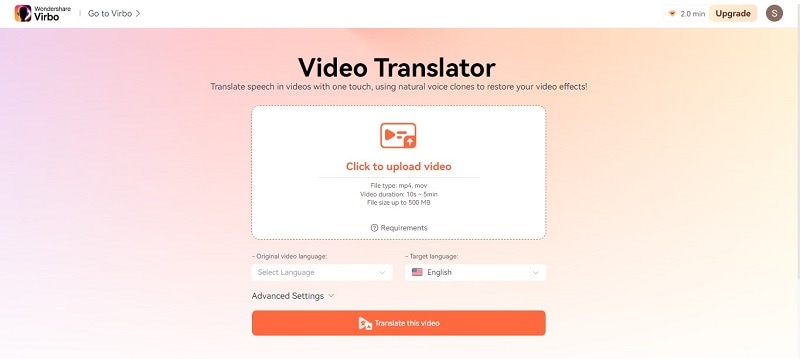
- Step 3: Specify Japanese as the Original video language and English as the desired Target language.
- Step 4: Virbo offers Advanced Settings to customize the translated view result. Toggle on the Lip-sync, Subtitle, and Proofread video script switches to enable them when needed.
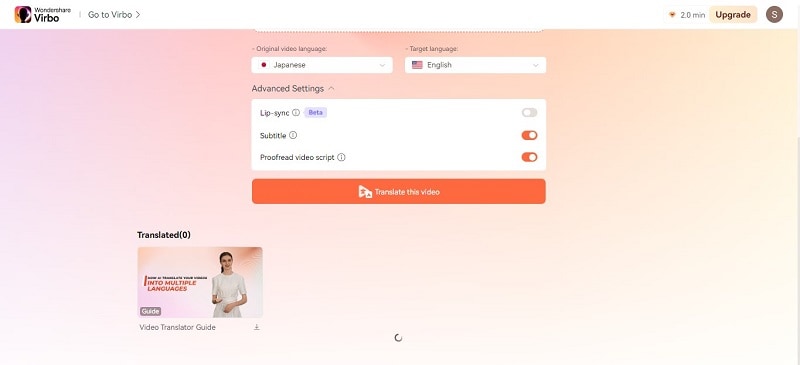
- Step 5: Click Translate this video to start the translation process once everything is set.
- Step 6: Wait a few moments while Virbo performs video transcription. Review the text and edit if needed.
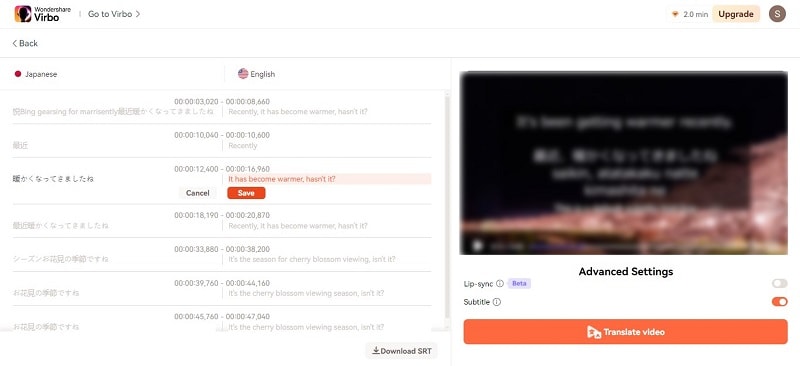
- Step 7: Click Translate video to proceed, then the video will go to the queue.
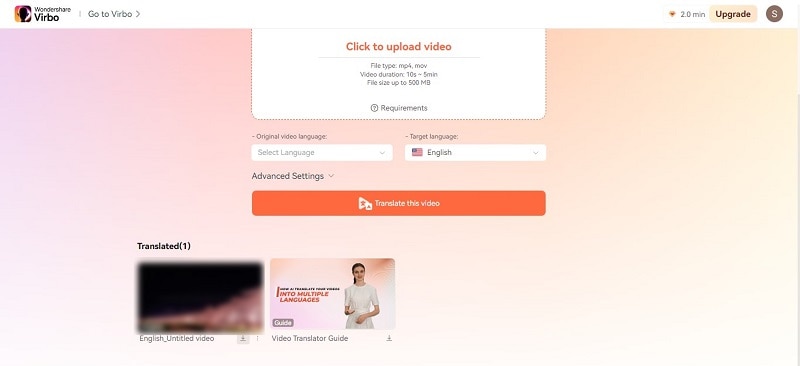
- Step 8: After completion, you can preview the translated video before downloading the final English version.
Part IV. How To Achieve the Best Video Translation Results?
You can’t always translate a video from Japanese to English without a few difficulties. Here are some ways to make the process easier for you:
Divide the Script Into Manageable Chunks
Break down the script into smaller sections like sentences, phrases, or even shorter segments depending on the video’s pace and complexity. It allows for more precise timing adjustments later.
Use a “Shadowing” Technique
As you watch the video, read the translated text out loud. Adjust the subtitle timing to match how you naturally speak. Doing this makes the flow feel more natural for you and the viewers.
Test and Refine
Now that you’ve set the timing for the subtitles, it’s time to put them to the test with your target audience. This step is important because it helps you catch any timing problems, awkward phrasing, or cultural differences that might have slipped through during editing.
Listen to what your audience says, and then use that feedback to tweak the subtitles. Your goal is to make sure they’re clear, short, and match the audience’s culture.
AI for Pre-Translation Tasks
Take advantage of AI tools for speech-to-text conversion and automatic subtitle generation. It can save time, but always proofread for accuracy and natural flow.
File Compatibility
Ensure your chosen translation service or tool supports the format of your video file. The common formats include MP4, MOV, and AVI.
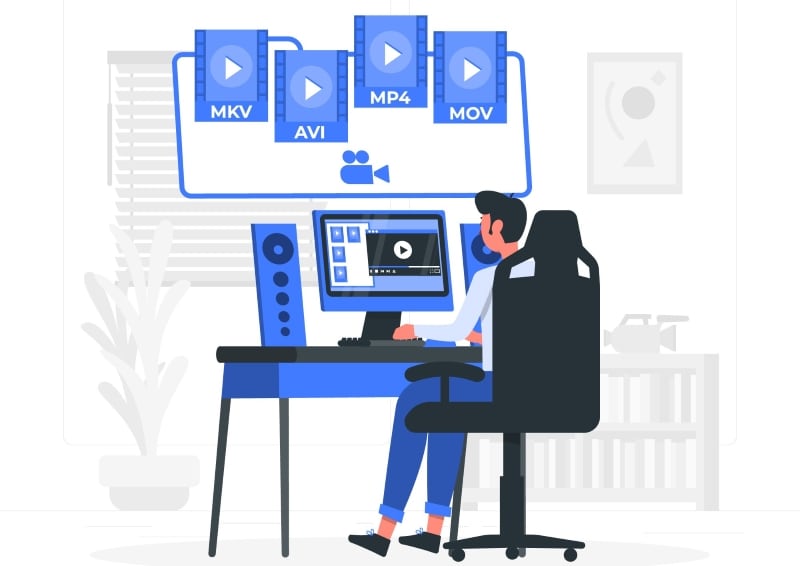
Conclusion
So you’ve seen how easy it can be to translate a video from Japanese to English. It’s up to you whether you will ask for the help of human translators, video editors, or AI video translators.
As you know, Virbo goes beyond being a basic Japanese to English video translator and converter. It takes the complexity out of translation, offering seamless and accurate results.
But remember, even the best AI translation can benefit from a human touch. Don’t be afraid to experiment and refine your translated video for the best outcome. With a little effort, you can bridge the language barrier and share your Japanese video content with the world.
Unlocking Global Audiences: Top Video Language Converters
In the ever-expanding digital landscape, content creators are presented with a unique challenge — the diverse linguistic preferences of a global audience.
Enter the transformative world of video language converters, essential tools that play a pivotal role in breaking down language barriers and fostering inclusivity in content creation. This article delves into the reasons behind the increasing need for video language converters and presents a curated list of the top 6 online tools, all of which offer free services.
Part 1: Why the Need Arises to Use the Video Language Converter in the Real-World
In the dynamic landscape of content creation, the demand for video language converter has surged, and with good reason. As content creators strive to engage a global audience, linguistic diversity becomes a critical consideration. Here, the video language converter emerges as an indispensable tool, addressing the challenge of language barriers and enhancing the accessibility of content across borders.
1. Cross-Cultural Communication
In a world characterized by cultural richness, effective communication necessitates breaking down language barriers. Video language converters facilitate cross-cultural communication by enabling creators to convey their messages in multiple languages. This, in turn, promotes a deeper understanding and appreciation of diverse perspectives.
2. Accessibility and Inclusivity
Accessibility is at the core of the video language converter’s role. By providing translations or subtitles, content becomes more inclusive, ensuring that individuals with varying language proficiencies can engage with and comprehend the material. This democratization of content aligns with the principles of diversity and inclusion.
3. Enhancing Educational Content
In the realm of educational content, video language converters play a crucial role in making learning materials accessible to a global audience. Whether its tutorials, lectures, or informative videos, translations break down language barriers, allowing students from different linguistic backgrounds to benefit from the content.
4. SEO and Discoverability
From a practical standpoint, leveraging video language converters enhances the discoverability of content. By providing translations or subtitles, creators improve the search engine optimization (SEO) of their videos, making them more likely to surface in searches conducted in different languages.
Part 2: Top 7 Video Language Converter Online Free
In the ever-evolving landscape of content creation, the availability of online tools simplifies complex processes. Video language converter online free, in particular, has become essential for creators seeking to make their content accessible to diverse audiences. Here, we explore six noteworthy online platforms that offer video language conversion services without any cost, empowering creators to bridge linguistic gaps seamlessly.
1. Wondershare Virbo
In the fast-paced world of digital content creation, the ability to communicate with a global audience is a game-changer. Virbo, a cutting-edge video language translator app, steps into this arena, offering content creators a dynamic platform to transcend linguistic barriers and connect with viewers worldwide. As we delve into Virbo, let’s explore its unique features, advantages, and considerations.

Features
- Whether you’re a seasoned creator or just starting, it’s user-friendly layout ensures a smooth and efficient experience.
- Its advanced speech recognition ensures accurate and nuanced translations, enhancing the audiovisual appeal of your content.
- It ensures that you can translate content dynamically as you create, providing instant feedback on how your video will resonate with a global audience.
Pros
- Its intuitive design ensures that creators of all levels can navigate the app seamlessly.
- Its extensive range of supported languages makes it a versatile tool for connecting with diverse audiences.
- Its commitment to user privacy ensures a secure environment for content creation and translation.
Cons
- It offers an offline mode; some features may be limited without an internet connection.
- For new users, the array of features may require some learning, but the intuitive design helps mitigate this.
Get Started Online Free Download
2. Veed.io
In the realm of online video editing, Veed stands out as a comprehensive platform that goes beyond the ordinary. With its integrated automatic subtitle generator and translator, it brings a new level of efficiency and creativity to content creation.

Features
- It excels in simplifying the subtitle creation process through its automatic generator, significantly reducing the time and effort required for manual transcription.
- The platform stands out with its translation feature, enabling creators to connect with a global audience by converting subtitles into various languages, promoting inclusivity.
- It offers a seamless integration of video editing tools, allowing users to enhance their content within the same platform, eliminating the need for multiple applications.
Pros
- It enables a smooth and efficient content creation process, saving time and effort.
- Its interface is user-friendly, fostering accessibility and ensuring a positive experience for creators at various skill levels.
- It allows users to access their projects from anywhere with an internet connection, promoting flexibility in content creation.
Cons
- It relies on a stable internet connection, which may pose challenges in areas with limited connectivity.
- It offers a range of features; it may not provide the depth of advanced editing tools available in standalone video editing software.
3. Kapwing
Kapwing emerges as a comprehensive video audio language converter, offering a suite of tools that includes a powerful subtitling feature. With a user-friendly interface, it caters to a diverse range of creators seeking versatility in their multimedia projects.

Features
- It offers a dynamic platform for creating subtitles with versatility, allowing users to customize and enhance their multimedia content effortlessly.
- It excels in facilitating seamless translation of subtitles, enabling content creators to reach a global audience by providing multilingual support.
- It provides a range of multimedia editing tools, allowing users to edit and enhance their videos with features like trimming, cropping, and adding additional elements.
Pros
- Its user-friendly approach ensures that both novice and experienced creators can utilize its features.
- Users enjoy creative freedom with its versatile editing tools, allowing them to express their ideas and enhance their content according to their vision.
- Its collaborative editing feature fosters teamwork, making it easy for multiple contributors to work together seamlessly on a project.
Cons
- Its free version may include a watermark on exported content.
- Its functionality relies on a stable internet connection.
4. Subtitle Horse
Subtitle Horse stands out as a dedicated online subtitle and captions editor designed to simplify the process of editing and translating subtitles. With a user-friendly interface and versatile subtitle customization options, it emerges as a valuable tool for content creators seeking efficiency and precision.

Features
- It provides a seamless platform for both editing and translating subtitles, offering a comprehensive solution for content creators looking to enhance their videos..
- It supports a variety of subtitle formats, ensuring compatibility with different video editing software and platforms, enhancing its usability.
- With a user-friendly interface, Subtitle Horse caters to both beginners and experienced users, making the subtitle editing process accessible and efficient.
Pros
- It provides a range of customization options, empowering creators to tailor subtitles to match the style and tone of their videos.
- It allows users to edit and adjust subtitles on the fly, providing immediate feedback and enhancing the efficiency of the subtitling process.
- It supports a range of video formats, enhancing its versatility and making it compatible with different types of video content.
Cons
- It may be less suitable for projects that involve extensive teamwork or contributions from multiple users simultaneously.
- An active internet connection is necessary for utilizing Subtitle Horse effectively.
5. Rev.com
Rev.com stands as a leading platform offering professional transcription and translation services tailored for video content creators. With a commitment to human-generated translations and a reputation for high-quality and accurate results, it emerges as a reliable solution for those seeking precision and professionalism in their video translations.

Features
- It facilitates effortless subtitle editing, allowing users to make precise adjustments to timing, text, and formatting.
- It supports a wide range of subtitle formats, ensuring compatibility with diverse video content.
- It provides users with customization options, allowing them to tailor subtitles to match the visual style of their content.
Pros
- It excels in offering a user-friendly experience, making it accessible to creators with varying levels of expertise in subtitle editing and translation.
- It streamlines the translation process, providing creators with a time-efficient solution to adapt their content for global audiences.
- It supports various formats ensures compatibility with a broad spectrum of video content.
Cons
- It often comes with a higher cost compared to automated alternatives.
- The reliance on human translators may introduce potential delays.
6. Trint
Trint takes center stage as an AI-powered transcription tool, redefining the landscape of subtitle creation with its automated transcription and translation capabilities. This platform not only simplifies the transcription process but also provides powerful tools for refining subtitles, making it a go-to choice for creators seeking efficiency and precision.

Features
- It goes a step further by offering translation services, allowing users to create multilingual subtitles effortlessly.
- From adjusting timing to refining text, these tools ensure that the subtitles align seamlessly with the content.
- Its AI-driven transcription ensures a high level of accuracy, minimizing errors in the transcribing process.
Pros
- It offers precise control over subtitle adjustments, allowing creators to achieve a polished and professional result.
- Its interface is designed to be user-friendly, catering to creators with varying levels of technical proficiency.
- It enables creators to focus more on content creation than on manual tasks.
Cons
- It operates on a subscription model, which may pose budget constraints for some users.
- It relies on a stable internet connection, which might be a limitation in areas with inconsistent connectivity.
7. Happy Scribe
Happy Scribe stands out as a comprehensive solution for creators seeking fast and accurate transcription and translation services for their audio and video content. With its automated capabilities and support for multiple languages, It streamlines the content creation process, making it an invaluable tool for various industries.

Features
- It employs advanced automation technology to transcribe audio and video content swiftly.
- It provides customizable options for transcriptions, allowing users to adapt the output to their specific requirements, whether for subtitles, captions, or written transcripts.
- It facilitates the creation of subtitles and captions for videos, enhancing accessibility and engagement for diverse audiences.
Pros
- It is designed with a user-friendly interface, ensuring that creators can navigate and utilize its features without extensive technical expertise.
- Its Collaborative tools enhance teamwork, allowing multiple users to contribute to transcription.
- It support for multiple languages caters to the diverse linguistic needs of content creators, expanding their reach and impact.
Cons
- It operates on a subscription model, which may present budget considerations for some users.
- Its functionality relies on a stable internet connection.
Part 3: FAQ about the Best Video Language Converter Online
Q1. How do online video language converters work?
These converters use advanced algorithms, machine learning, or a combination of both to analyze the audio or text content of a video. They then generate accurate translations or subtitles based on the identified language, providing a multilingual experience for viewers.
Q2. Can online video language converters translate multiple languages?
Yes, several online video language converters support translation into multiple languages. They are designed to cater to a diverse global audience and provide subtitles or translations in various linguistic landscapes.
Q3. Is there a limit to the video length that online converters can handle?
The capacity to handle video length varies among converters. Some platforms may have limitations on video duration for free versions, while premium versions or professional tools often offer more extensive capabilities.
Q4. Are the translations provided by online converters accurate?
The accuracy of translations can vary depending on the platform. While many online video language converters strive for precision, factors such as language complexity, context, and accents may influence the accuracy of the final output.
Q5. How can I choose the best online video language converter for my needs?
Consider factors such as the languages supported, accuracy of translations, ease of use, collaboration features, and any additional functionality offered. It’s beneficial to explore user reviews and platform specifications to find the converter that aligns with your specific requirements.
Generate Engaging
AI Video in Minutes!
Easily convert text into professional spokesperson videos in over 120+ voices & languages in minutes.
Generate AI Video Free Generate AI Video Now

Conclusion
In conclusion, the era of online video language converters signifies a significant leap in global communication. Whether you’re a content creator or a business expanding its reach, these tools offer a bridge to cross-cultural understanding. Embrace their power, and embark on a journey where every word resonates globally, connecting diverse communities in the vast landscape of digital content.
Easily convert text into professional spokesperson videos in over 120+ voices & languages in minutes.
Generate AI Video Free Generate AI Video Now

Conclusion
In conclusion, the era of online video language converters signifies a significant leap in global communication. Whether you’re a content creator or a business expanding its reach, these tools offer a bridge to cross-cultural understanding. Embrace their power, and embark on a journey where every word resonates globally, connecting diverse communities in the vast landscape of digital content.
Chrome Video Translators: Top 5 Video Translation Chrome Extensions
Videos are a vital source of communication with a diverse audience on many platforms. They can engage viewers belonging to education, business, or any other sectors. People translate videos into different languages for the global reach of video content. Translating videos can help to avoid misinterpretations and make content relatable for all.
For this purpose, Chrome video translator tools serve many advantages to users. Google Chrome offers several translation extensions to translate videos and assist language learners. Read this article and learn the benefits of using translators in various industries. Besides, you will find some top-notch translate Google Chrome extensions online.
Part 1. Industries Benefit from The Feature of Chrome Video Translation
The feature of Chrome video translator proves helpful in breaking language barriers. Many public and private companies use such extensions to expand their content’s impact. For instance, manufacturing companies can use translated videos for safety training and instructions. So, let’s delve into the detailed implications of using Chrome translators below:
- Education: Translated videos assist remote students in learning in their native language. This way, language learning, and cross-cultural studies become easier for diverse students. They can understand complex topics through video-translated material or subtitles.
- Healthcare: Language barriers can lead to misdiagnosis of telemedicine. Video translation allows doctors to participate in global meetings in their inborn language. It also helps patients to know pre-surgery instructions and medical advice.
- E-commerce: Language barriers can hinder business expansion and product demonstration. Chrome Translate allows websites to create multi-language advertisements for websites. It aids in effective marketing and global reach to potential customers.
- News and Journalism: Video translation informs viewers during live news broadcastings. It facilitates cross-border communication and also assists impaired viewers. Chrome video translators meet ethical reporting demands by providing accurate translations.
- Public Services: Government agencies use translated videos to guide non-native visitors. They ensure that all the critical information is accessible to everyone. In such cases, translated videos can educate the public about emergency situations.
- Technology and Software: Startups and technology companies need investors and partners. Thus, they use translated videos to convey their technical concepts. These companies provide support material for the purchased software in translated video format.
Part 2. Top-Known Chrome Extensions for Translating Video Content
Google Chrome extensions are software programs added to the Chrome web browser. They enhance the functionality of the browser with a personalized experience for users. Using extensions normally automates repetitive tasks and boosts productivity. You can find the best Chrome video translator to make quick video translations:
1. iTour Video Translation
This Chrome extension can translate the audio from your selected video. It can translate online meetings from Zoom, Google Meet, Canva, and Microsoft Teams. International students use it to detect spoken lectures and turn them into text. To get subtitles played on your computers, you have to set the sound source to a microphone.

Key Features
- Online videos can be translated into 2 language subtitles.
- Users can adjust the font size of subtitles from large to small and medium options.
- It can translate phone calls, Messenger, WhatsApp, and video calls to ease communication.
Rating | 4.9/5 |
Total Users | 40,000+ |
Size | 2.36 MB |
2. Auto Translate for YouTube
To activate automatic subtitles, you can use this YouTube subtitle translator Chrome. Some videos on YouTube do not offer subtitles. This extension can not only provide subtitles but also translate them into your desired language. With just one click, users can get automated subtitles of any chosen YouTube video.

Key Features
- You can upload and save subtitles on Notepad to share them later.
- Auto Translate for YouTube allows you to adjust the copyright of subtitles from the pop-up section.
- Posting and sharing the link of subtitles on Twitter, Facebook, and LinkedIn.
Rating | 3.9/5 |
Total Users | 70,000+ |
Size | 327KB |
3. Video CC Translator
Translate closed captions provided by video platforms such as Udemy and YouTube with Video CC Translator. It gives you an option to enable captions of the video. Furthermore, users can choose the font weight and text alignment from several options. It allows you to define the subtitles’ font size and opacity with the sliders available.

Key Features
- It supports all languages that are available on Google Translator.
- You can change the position of subtitles as per readability.
- There are many subtitle styles available that users can set as desired.
Rating | 4.7/5 |
Total Users | 10,000+ |
Size | 295KB |
4. Ultimate Video Translator
Social communication with global listeners gets easier with this Chrome video translator. This extension offers YouTube video subtitles and captions. In this regard, you have to choose a language and manually give a prompt to start the process. It lets you share the translated video on Twitter and other streaming platforms.

Key Features
- Translate captions or subtitles on one page.
- Provides integration with video streaming platforms like YouTube, NRKTV, etc.
- Download video subtitles and share them on social networks.
Rating | 2.6/5 |
Total Users | 90,000+ |
Size | 328KB |
5. Video Translator - Translate Video Online
Are you looking for an extension to translate videos quickly online? This extension offers AI-powered video translation technology to translate with 99% accuracy. Business owners, content creators, and marketers get benefits from this Chrome translate extension. It is also useful for making instructional and educational videos for international viewers.

Key Features
- Offer translation of video content in more than 21 languages.
- Allows you to choose the language and paste the URL link of the video for translation.
- It can transcribe speech and translate it into other languages with OpenAI support.
Rating | 3.8/5 |
Total Users | 3,000+ |
Size | 228KB |
Part 3. Chrome Extensions vs. Offline Tools
In the above sections, we have highlighted a few Chrome video translator extensions. Notably stating, most of them can translate subtitles only and do not offer video translation. If we compare it with offline tools, such extensions also require an active internet connection. They also lack translated video saving and sharing to your device.
Thus, you should consider an offline tool that allows you personalization options. Look for a tool with translating customization options like selecting a gender, voice, or accent. In this regard, you can head to the next section and explore such a video translation tool.
Part 4. Wondershare Virbo: Your Answer to Video Translation With AI
People who seek comprehensive and quick video editing can actually dream of it now. Wondershare Virbo is an AI tool to generate engaging AI videos. It can meet your needs for business, education, or social media video presentations. You can create AI avatar videos and photos by pasting the script. To enhance videos, it allows you to insert stickers, text, and backgrounds from its resources.
While it provides some top-notch video-creating and editing features, you can make professional content out of your visualized ideas. This makes it one of the best tools to work with for video content creation.
AI Translate Videos – A New Feature To Look Out For
Communicate with the whole world by using this AI feature of Virbo. It provides you with customization options for translating videos. Firstly, you have to select a translating voice or language from more than 300 choices. Then, you are required to upload an MP4 video ranging from 10 seconds to 2 minutes. Despite translating videos, it can generate translated subtitles.
This feature also allows you to choose a gender, voice tone, style, and accent for translation. Besides, you can keep the background music in the video while translating just human voices. Users can still adjust the translated video on voice speed, volume, and pitch.
Translate Video Online Free Download
Other Features of Wondershare Virbo
- AI Script: Generate your marketing plan with ChatGPT and Virbo integration. This feature allows you to insert prompts of up to 2,000 characters in the AI Script section. You can select shorten, expand, or happier styles for smart optimization of content. To convert the generated text into speech, you have to choose landscape or portrait mode of video.
- AI Avatar: Video making doesn’t need any camera or crew when AI avatars are available. There are more than 300 AI avatars of different attire, age range, and ethnicities. You can choose an avatar from western, eastern, business, or causal sections. After selecting one, set their location, layer, and style from a circular or full-body view.
- Video Templates: Get predesigned video templates from your required niche. Pick one from advertisement, social media, or explainer video domains. The video templates are available in two aspect ratios of 16:9 and 9:16. After choosing one template, users can still customize it as needed. It allows you to change your avatar, insert text, or adjust the video background.
- AI Talking Photos: Make your talking photos and boost content engagement with this creativity. Virbo offers almost 10 templates of AI-talking photos in its library. Apart from that, you can import your images to make it talk. In this regard, you are asked to upload a straight-pose picture. Later, paste a script and let them speak the content with AI support.
How to AI Translate Video With Wondershare Virbo
Virbo enables users to translate videos into various accents, voices, and tones. Let’s delve into the steps and learn how to get a translated video.
Translate Video Online Free Download
Step 1: Get Wondershare Virbo and Access Video Translator Feature
Launch Wondershare Virbo in your system after downloading from its official website. Enter the main home screen of Virbo and look for the “Video Translator” option on the right side. Click on it and navigate toward another pop-up screen.

Step 2: Import the Video and Set Translating Parameters
As you navigate into the “Video Translator” screen, select the “Upload” button. Browse the video you want to translate and hit the “Open” button. After that, press the downward symbol of “Original Language” to choose the video’s language. Next, head to the “Translate Language” and pick an intended language from the drop-down list. Lastly, hit the “Translate” button and get the video preview.

Step 3: Export the Video in Your System
The platform automatically takes you into the “My Creations” section, where you can view the status of the video completion. Once it successfully exports, select and view the video to check the quality of the translation. If you are satisfied, click the “Download” button to export the video to your device.

Translate Video Online Free Download
Conclusion
In short, translated videos are valuable sources for global communication. For this purpose, Chrome video translator extensions are used in many industries. This article has shed light on Chrome extensions that give translation of subtitles. So, using offline tools is preferable in this regard. They are better than such extensions due to the customization options in translation.
Take the example of Wondershare Virbo, which offers AI translation in human-like voices. Unlike Chrome Extensions, you can define your translating parameters. It can turn your video into targeted language and select voice, tones, and accents. Apart from translation, it also provides AI avatars, video templates, and much more. That’s why this AI tool is worth trying if compared with Chrome Extensions.
Translate Video Online Free Download
Comprehensive Guide for Free Video Translator Downloading
Welcome to our comprehensive guide on video translator download, your gateway to a diverse world of multimedia content. In an era where connecting with a global audience is paramount, the ability to break language barriers through video translation is a game-changer. Whether you’re a content creator, language enthusiast, this guide will walk you through the essential factors to consider, step-by-step instructions for a seamless video translator download, and address common questions related to translating English to Hindi videos.
Part 1: Step-by-step Instructions for Video Translator Downloading

Now that we’ve explored the crucial factors to consider when venturing into video translation let’s embark on a practical journey — downloading a video translator. Follow these step-by-step instructions to integrate this powerful tool into your content creation toolkit seamlessly. Additionally, we’ll recommend two reputable video translator apps to guide you through the installation process.
A Versatile Video Translator Tool: Virbo
As a multilingual tool, Virbo takes real-time translation to the next level. Accessible online and through dedicated applications, Virbo boasts advanced features that enhance communication dynamics. Its capabilities extend to video language translation, making it a valuable addition to the subtitle translation toolkit.
Step 1: Visit the official Virbo website or use the dedicated software/app.
Generate Voice Online Download APP Now Free Download
Step 2: Upload your desired file for instant translation.

Step 3: Choose the target language for translation. Virbo’s extensive language support allows you to cater to a broad audience.

Step 4: Click the “Translate” button, triggering the initiation of the translation process.
Translating English to Hindi Made Easy: Descript
Descript is a revolutionary platform that redefines the landscape of audio and video editing. Pioneering the concept of text-based editing, it allows users to edit multimedia content as easily as editing a document. With its intuitive interface, users can manipulate audio and video files by simply editing the transcribed text, seamlessly making changes to the corresponding media.
Step 1: Navigate to the official Descript Translator website, the digital haven where linguistic precision meets innovation.

Step 2: Upload your video file directly onto the platform, initiating the process of transforming spoken words into the language of your choice.

Step 3: Customize your translation experience by choosing your desired language.

Step 4: Once the translation is complete, download the translated text or share it directly from the platform.
Part 2: Important Factors to Consider While Translating Videos
In the vibrant landscape of digital content, the ability to transcend linguistic boundaries is a crucial aspect of reaching a diverse audience. When venturing into the realm of video translation, it’s essential to consider various factors to ensure an accurate and meaningful representation of your content. Let’s delve into the key considerations that can significantly impact the quality of your video translations.
1. Content Accuracy
In the intricate dance of video translation, accuracy takes center stage. When selecting a video translation tool, it’s imperative to prioritize those that not only promise but guarantee precise content translation. The soul of your message lies in its accuracy, and choosing a tool that preserves the essence and nuances of the original message establishes a deep and meaningful connection with your viewers through every frame of the translated content.
2. Language Support
The beauty of global content creation lies in its linguistic diversity. Opt for a video translator that transcends language boundaries—a true polyglot. Choosing a tool with broad language support empowers you to cater to the diverse linguistic preferences of your audience, creating an inclusive and accessible viewing experience. Your selected tool should be a gateway to a world where language is not a barrier but a bridge.
3. Subtitle Customization
Visual elements, especially subtitles, contribute significantly to the overall viewer experience. Seek a video translator that goes beyond the basics, offering options for customizing subtitles. The ability to adjust not only the appearance but also the timing of subtitles ensures that your translated content aligns seamlessly with the rhythm and tone of your original video. This customization transforms your subtitles from a mere translation tool to an integral part of your storytelling.
4. User-Friendly Interface
In the fast-paced and dynamic landscape of content creation, efficiency is the key to success. Choose a video translation tool adorned with a user-friendly interface—a design that is intuitive and serves as a compass guiding both beginners and experienced users effortlessly through the translation process. A tool that feels familiar and accessible contributes not only to a smoother workflow but also to a more enjoyable and productive content creation experience.
5. Offline Functionality
In a world where the ubiquity of the internet is not guaranteed, the ability to navigate offline is a valuable asset. Consider a video translator that offers offline capabilities, allowing you to enjoy translated content even when a stable internet connection is elusive. This feature provides convenience and flexibility, ensuring your content creation journey is not hindered by connectivity constraints.
Break Language Barriers Now with Wondershare Virbo - Video Translator!
Part 3: FAQs Related to Translating English to Hindi Video and Downloading it
As you delve into the realm of video translation, it’s natural to have questions about the process, especially when aiming to translate content from English to Hindi. Let’s address some frequently asked questions to provide clarity and guidance on translating English to Hindi videos and the downloading process.
Q1. Can I Download a Video Translator for Free?
Yes, many video translators like Virbo offer free versions with basic features. It’s advisable to visit the official website of your chosen video translator to obtain accurate information on free and premium offerings.
Q2. Is Offline Translation Possible?
Many video translators offer offline functionality. During the download process, check for features related to offline translation to ensure that the tool supports this capability. Offline functionality allows you to work on translations even without a stable internet connection.
Q3. Can I Customize Subtitles for Translated Videos?
Yes, Virbo video translators allow the customization of subtitles. Explore the settings or preferences within the downloaded tool to adjust the appearance, timing, and other aspects of subtitles.
Q4. Are There Specific Video Formats Supported by the Translator?
So far, Virbo only allows uploading MP4 files. Stay tuned for future updates!
Conclusion
In a nutshell, the dynamic landscape of video translation is a journey marked by precision, creativity, and accessibility. As creators, language enthusiasts, or viewers, our exploration has unveiled a spectrum of considerations crucial for a seamless and enriching experience.
Armed with these insights, venture into the world of video translation with confidence, knowing that every frame carries the power to resonate across borders, fostering a global connection through powerful translation tools like Wondershare Virbo.
Generate Voice Online Download APP Now Free Download
Step 2: Upload your desired file for instant translation.

Step 3: Choose the target language for translation. Virbo’s extensive language support allows you to cater to a broad audience.

Step 4: Click the “Translate” button, triggering the initiation of the translation process.
Translating English to Hindi Made Easy: Descript
Descript is a revolutionary platform that redefines the landscape of audio and video editing. Pioneering the concept of text-based editing, it allows users to edit multimedia content as easily as editing a document. With its intuitive interface, users can manipulate audio and video files by simply editing the transcribed text, seamlessly making changes to the corresponding media.
Step 1: Navigate to the official Descript Translator website, the digital haven where linguistic precision meets innovation.

Step 2: Upload your video file directly onto the platform, initiating the process of transforming spoken words into the language of your choice.

Step 3: Customize your translation experience by choosing your desired language.

Step 4: Once the translation is complete, download the translated text or share it directly from the platform.
Part 2: Important Factors to Consider While Translating Videos
In the vibrant landscape of digital content, the ability to transcend linguistic boundaries is a crucial aspect of reaching a diverse audience. When venturing into the realm of video translation, it’s essential to consider various factors to ensure an accurate and meaningful representation of your content. Let’s delve into the key considerations that can significantly impact the quality of your video translations.
1. Content Accuracy
In the intricate dance of video translation, accuracy takes center stage. When selecting a video translation tool, it’s imperative to prioritize those that not only promise but guarantee precise content translation. The soul of your message lies in its accuracy, and choosing a tool that preserves the essence and nuances of the original message establishes a deep and meaningful connection with your viewers through every frame of the translated content.
2. Language Support
The beauty of global content creation lies in its linguistic diversity. Opt for a video translator that transcends language boundaries—a true polyglot. Choosing a tool with broad language support empowers you to cater to the diverse linguistic preferences of your audience, creating an inclusive and accessible viewing experience. Your selected tool should be a gateway to a world where language is not a barrier but a bridge.
3. Subtitle Customization
Visual elements, especially subtitles, contribute significantly to the overall viewer experience. Seek a video translator that goes beyond the basics, offering options for customizing subtitles. The ability to adjust not only the appearance but also the timing of subtitles ensures that your translated content aligns seamlessly with the rhythm and tone of your original video. This customization transforms your subtitles from a mere translation tool to an integral part of your storytelling.
4. User-Friendly Interface
In the fast-paced and dynamic landscape of content creation, efficiency is the key to success. Choose a video translation tool adorned with a user-friendly interface—a design that is intuitive and serves as a compass guiding both beginners and experienced users effortlessly through the translation process. A tool that feels familiar and accessible contributes not only to a smoother workflow but also to a more enjoyable and productive content creation experience.
5. Offline Functionality
In a world where the ubiquity of the internet is not guaranteed, the ability to navigate offline is a valuable asset. Consider a video translator that offers offline capabilities, allowing you to enjoy translated content even when a stable internet connection is elusive. This feature provides convenience and flexibility, ensuring your content creation journey is not hindered by connectivity constraints.
Break Language Barriers Now with Wondershare Virbo - Video Translator!
Part 3: FAQs Related to Translating English to Hindi Video and Downloading it
As you delve into the realm of video translation, it’s natural to have questions about the process, especially when aiming to translate content from English to Hindi. Let’s address some frequently asked questions to provide clarity and guidance on translating English to Hindi videos and the downloading process.
Q1. Can I Download a Video Translator for Free?
Yes, many video translators like Virbo offer free versions with basic features. It’s advisable to visit the official website of your chosen video translator to obtain accurate information on free and premium offerings.
Q2. Is Offline Translation Possible?
Many video translators offer offline functionality. During the download process, check for features related to offline translation to ensure that the tool supports this capability. Offline functionality allows you to work on translations even without a stable internet connection.
Q3. Can I Customize Subtitles for Translated Videos?
Yes, Virbo video translators allow the customization of subtitles. Explore the settings or preferences within the downloaded tool to adjust the appearance, timing, and other aspects of subtitles.
Q4. Are There Specific Video Formats Supported by the Translator?
So far, Virbo only allows uploading MP4 files. Stay tuned for future updates!
Conclusion
In a nutshell, the dynamic landscape of video translation is a journey marked by precision, creativity, and accessibility. As creators, language enthusiasts, or viewers, our exploration has unveiled a spectrum of considerations crucial for a seamless and enriching experience.
Armed with these insights, venture into the world of video translation with confidence, knowing that every frame carries the power to resonate across borders, fostering a global connection through powerful translation tools like Wondershare Virbo.
Generate Voice Online Download APP Now Free Download
How To Convert Video Voice to Text Online for Free?
Do you ever struggle to understand or keep up with long videos? Maybe you need the information in text format for easier note-taking or sharing. However, transcribing the video content manually can be a time-consuming task.
The good news is that you can easily convert video voice to text online for free. In this guide, you’ll explore several ways to do it using the best tools and some tips if you encounter any issues. So, whether you’re dealing with online meetings, e-learning content, or working on global campaigns, this article has a solution for you. Let’s start.

Part 1. For Online Meetings on Desktop: Convert Video Voice to Text by Descript
Joining online meetings might get tricky when crucial details slip by because of fast speakers or background noise. Don’t worry – Descript has your back. It is a versatile video recorder that doubles as a video voice-to-text converter online.
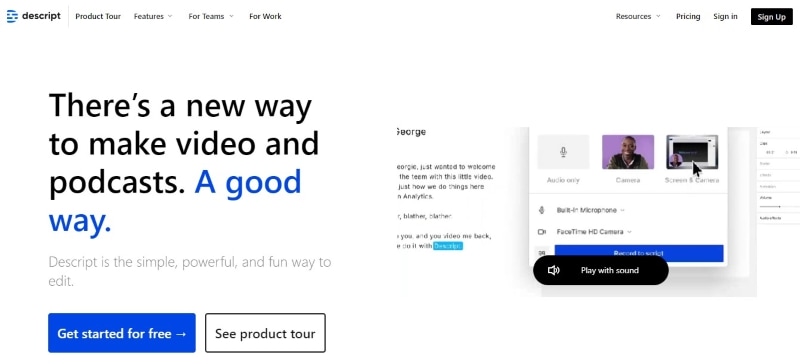
With Descript, you can easily review key points, find specific moments, and share the transcript with colleagues who couldn’t make it. Say goodbye to missed details and hello to smoother online meetings with Descript.
How To Convert Video Voice to Text Automatically Using Descript?
With Descript, online meetings become active and focused. Ready to give it a try? Follow these steps below to convert your recorded video to text files online with Descript:
- Step 1: Launch Descript from your web browser and create an account.
- Step 2: Click + New in the top right corner of the Projects on the home page. Then, go to Video project > Add file, and select your video file from the pop-up window.

- Step 3: Descript will automatically begin transcribing your video once it’s uploaded.
- Step 4: You’ll see the converted text on the left. Just click on it to make any changes you need.
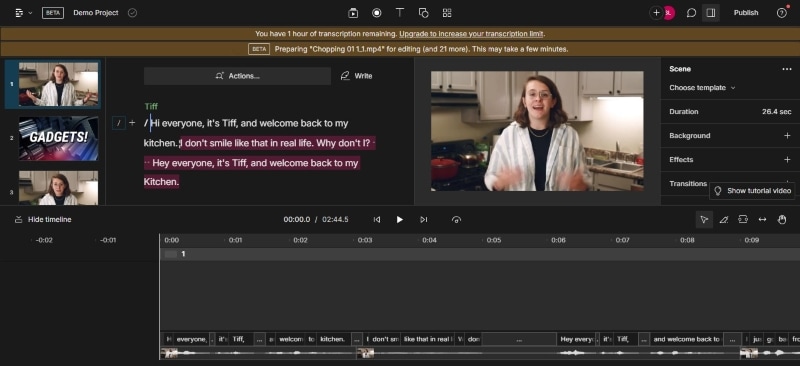
Tips:
Click the “**Actions…” button on the text editor and select “Remove filler words…**” to search and delete filler words in the text automatically.
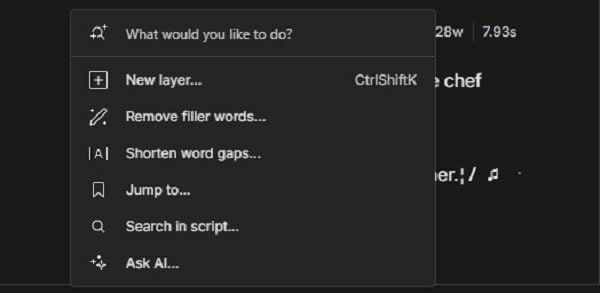
- Step 5: Once you’re happy with the transcript, you can export it in various formats. Go to File in the top navigation pane and select Export.
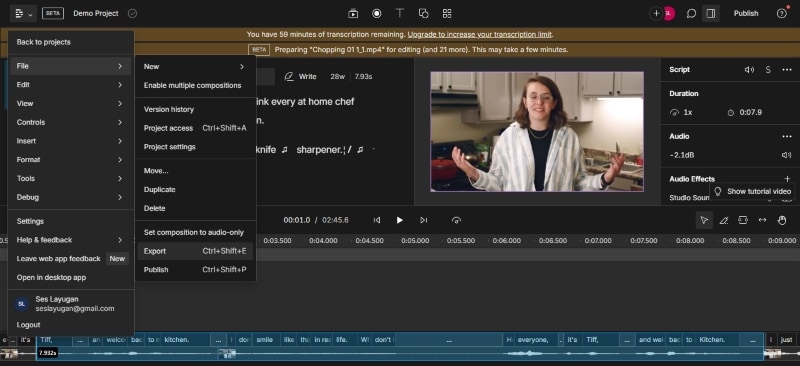
- Step 6: Go to the Transcript tab bar from the pop-up window. Choose the desired format (TXT, DOCX, etc.) and customize the export settings.
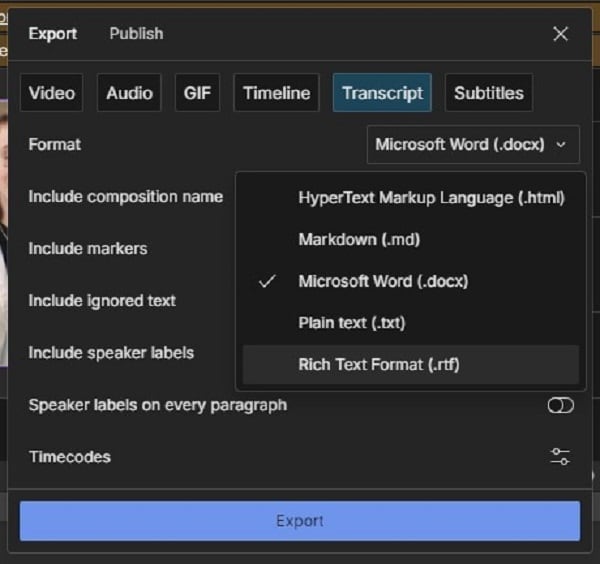
Part 2. For E-Learning Online: Convert Video Voice to Text by Happy Scribe
Getting new skills through e-learning is great, but listening to long video lectures can be tiresome. But with AI tools like Happy Scribe, it is easier to study. It has an intuitive interface and lets you convert video voice to text online for free.
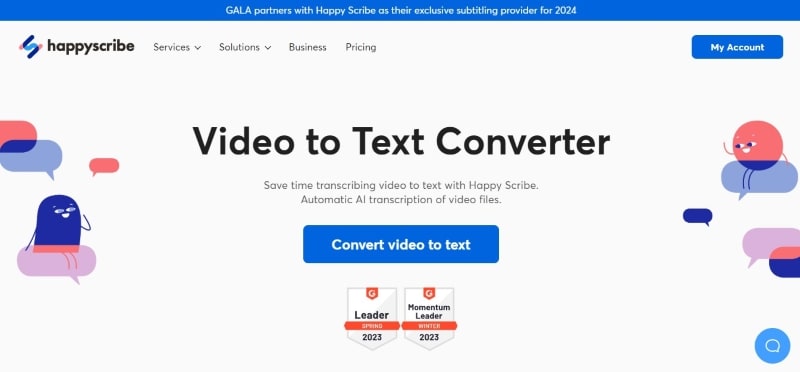
Happy Scribe’s AI transcribes your video, whether pre-recorded or from YouTube, giving you a text version of the lecture. Now, you can review the important things at your speed and find specific info faster.
How To Convert Video Voice to Text Using AI With Happy Scribe?
You can use Happy Scribe as a YouTube video voice-to-text converter online. The first 10 minutes are free; you can try it out for short videos or snippets. Here’s how to use Happy Scribe for video transcription online:
- Step 1: Head to Happy Scribe’s website and log in to your existing account. If you’re a new user, sign up for a free account.
- Step 2: Choose the upload source:
- Click Upload a fileand select your video from your desktop folders.
- Paste the public video URL from YouTube, Google Drive, and more into the designated field.
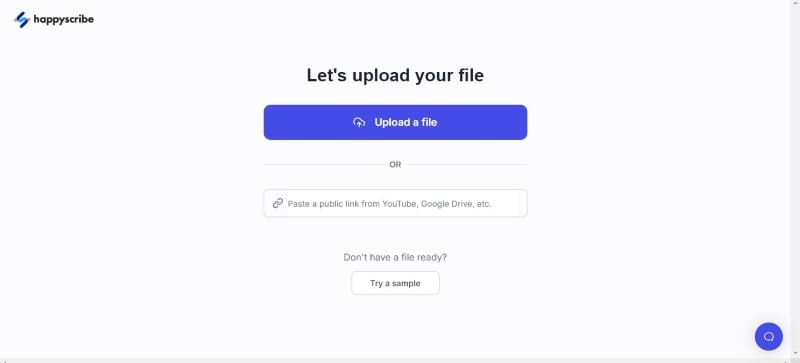
- Step 3: A pop-up window will appear once you’ve chosen the upload source. Choose the language spoken in your video from the dropdown menu. Then, select Machine generated as the transcription method.
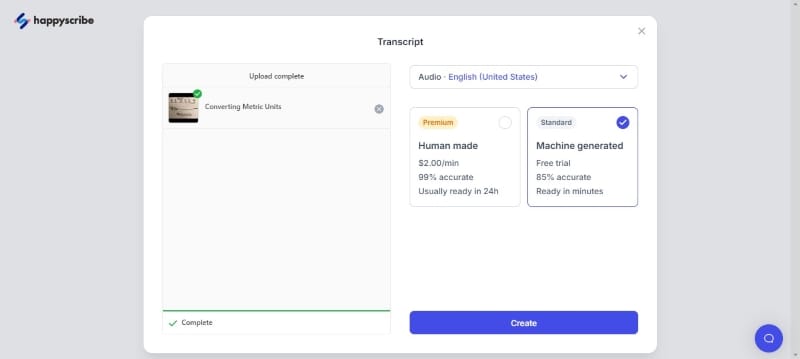
- Step 4: Click Create after setting your options. Happy Scribe YouTube video voice-to-text converter online will upload and process your video.
- Step 5: Happy Scribe will automatically generate a transcript. Use the built-in editor to click on any section of text to edit and correct mistakes. You can also control playback speed to make editing easier.
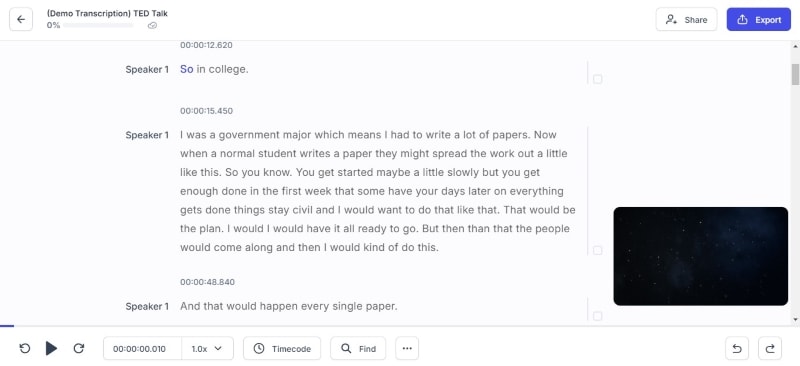
- Step 6: Once done editing the transcript, click Export from the upper right navigation pane. Since you are using the app for free, you can download it in text document and SRT file formats. Click Export 1 file to save the transcript to your computer.
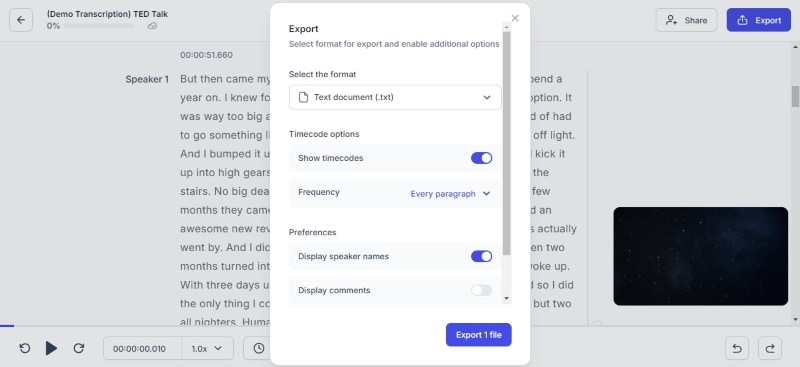
Moving beyond desktop meetings and e-learning, businesses often need an easier and faster way to translate video content for a global audience. That is where AI video translation can help you. In the next part, you’ll explore how Wondershare Virbo can help you efficiently translate video voice to text in multiple languages. Read on to make your marketing materials accessible to a wider audience.
Part 3. Virbo: Best Video Voice-to-Text Translator Online for Global Marketing
When taking your brand global, language barriers can be a challenge. But here’s the good news: with Virbo, it’s doable. One of its highlights is the ability to accurately translate video voice to text.
Virbo makes global marketing easier.

Get Started Online Free Download
This app uses AI to transcribe your video’s audio into text. Then, it lets you translate that text into different languages. Want to go the extra mile? Add these translated captions to your video, and voila! You’ve made your content accessible to viewers worldwide. This way, you can create professional, multilingual video content that expands your reach and increases brand recognition across borders, all within a single platform.
Here’s what makes Virbo the best video voice-to-text translator online for your global marketing endeavors:
- **Support for 20+ Languages:**With Virbo, you can translate video voice to text in different languages, including popular choices like Spanish, English, Chinese, and more.
- **Cross-Platform Compatibility:**Marketing knows no borders, and neither does Virbo. Whether you’re a seasoned techie or a casual user, Virbo seamlessly adapts to your workflow. It works on Windows desktops, iOS, and Android devices and even directly on your web browser.
- **Easy To Use:**Virbo understands that time is precious, especially in business. That’s why it boasts an intuitive interface that anyone can navigate easily.
- **High-Quality Output:**When it comes to your brand message, clarity is paramount. Virbo ensures your translated content maintains its original meaning and impact. Its high-quality translation output guarantees your message resonates with your global audience just as intended.
- Budget-Friendly App: Reaching a global audience shouldn’t break the bank. Virbo offers its powerful features at an affordable price, making it an excellent choice for businesses of all sizes. Now, you can translate video voice to text without worrying about hefty costs.
How To Translate Video Voice to Text Automatically Using Virbo AI?
Virbo offers free video translation with subtitles, up to 2 minutes per video. Here’s how to translate video voice to text online in a few easy steps:
- Step 1: Click Translate Video Online from the Virbo video translator webpage. You can also download the app on your desktop. Then, create or login to an account.
Get Started Online Free Download
- Step 2: Upload your video file in MP4 or MOV format. Select the language spoken in your video from the dropdown menu. Then, choose the language you want the subtitles for and translate the text into. Click Translate this video to continue.
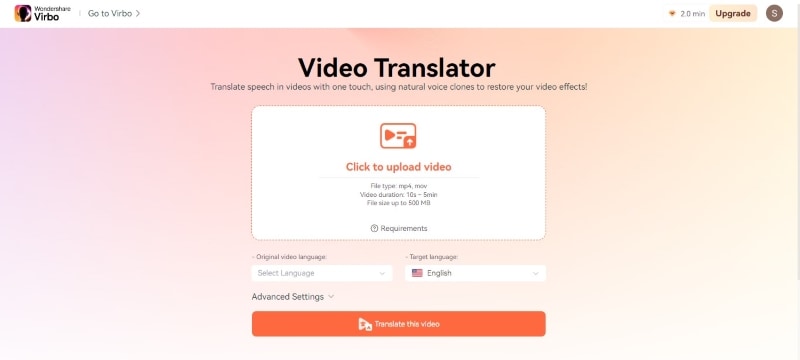
Tips:
Advanced Settings (Optional):
- **Subtitle:**Enable this to generate subtitles in the target language based on the transcribed text.
- **Proofread video script:**This allows reviewing and editing the transcribed text before translation.
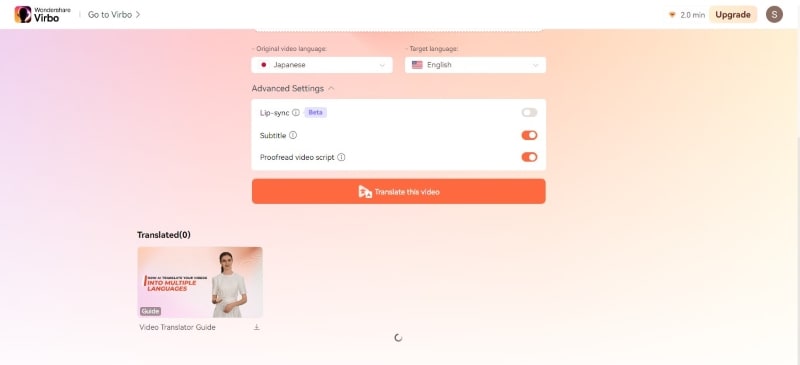
- Step 3: Virbo will process your video. This may take some time depending on the video length.
- Step 4: Review and edit any errors on the text editor before proceeding. Once satisfied, download the subtitles file (SRT format).
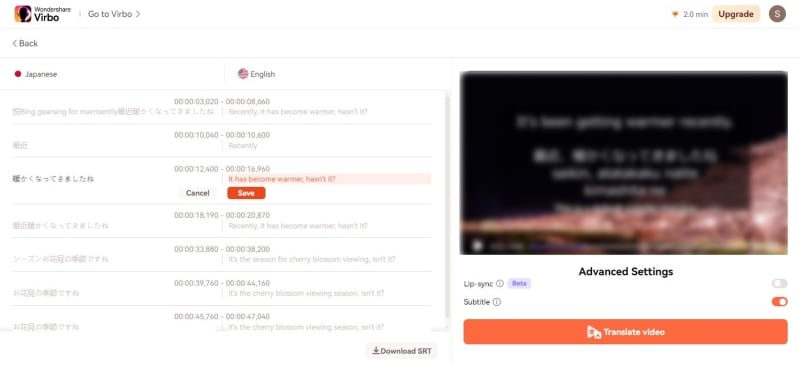
- Step 5: Click Translate video to add the translated text or subtitle to your original video. After processing is complete, Virbo will provide you with a preview of the translated video with subtitles (if enabled). If you’re satisfied with the results, click the Download icon to save the translated video with subtitles to your computer.
Part 4. Troubleshooting Issues When Converting Video Voice to Text
Creating clear and accurate transcripts is essential for professional settings. Here’s how to avoid common pitfalls that can impact transcription quality:
Issue 1: Background Noise
Solution: Noisy recordings can cause problems with transcription accuracy. Luckily, many video editing programs have noise-reduction features. Running your audio through one of these before conversion can make a big difference.
Issue 2: Accents or Dialects
Solution: Most speech recognition software is good these days, but accents and dialects can still trip them up. Check your software’s settings for options to adjust the recognition model. Some programs even let you upload a sample of the speaker’s voice to improve accuracy.
Issue 3: Punctuation Errors
Solution: Some software offers built-in punctuation correction you can use. If unavailable, find a separate grammar tool after conversion. Always proofread the transcript yourself for any missing punctuation.
Issue 4: Overlapping Voices of Speakers
Solution: If the video has multiple speakers, try software that can differentiate voices. This includes interviews and panel discussions. You can always transcribe each speaker’s section if that’s not an option. Then, add timestamps to identify speaker changes in the transcript.

Issue 5: Inconsistent Transcription Format
Solution: Most video-to-text software allows you to format after the converter generates the transcript. You can adjust fonts, add paragraph breaks, and even format speaker identification within the program. Also, you can always export the transcript to a word processor for in-depth formatting.
Conclusion
You learned several ways to convert video voice to text online for free and the best apps for it. These tools make videos easier to understand, whether recorded or uploaded from websites like YouTube.
Now, you also know the best app to translate video voice to text. Virbo allows you to translate your videos into different languages using AI, making your content global. So, explore these tools, see how video text conversion helps, and choose the app that fits you best.
Do you ever struggle to understand or keep up with long videos? Maybe you need the information in text format for easier note-taking or sharing. However, transcribing the video content manually can be a time-consuming task.
The good news is that you can easily convert video voice to text online for free. In this guide, you’ll explore several ways to do it using the best tools and some tips if you encounter any issues. So, whether you’re dealing with online meetings, e-learning content, or working on global campaigns, this article has a solution for you. Let’s start.

Part 1. For Online Meetings on Desktop: Convert Video Voice to Text by Descript
Joining online meetings might get tricky when crucial details slip by because of fast speakers or background noise. Don’t worry – Descript has your back. It is a versatile video recorder that doubles as a video voice-to-text converter online.

With Descript, you can easily review key points, find specific moments, and share the transcript with colleagues who couldn’t make it. Say goodbye to missed details and hello to smoother online meetings with Descript.
How To Convert Video Voice to Text Automatically Using Descript?
With Descript, online meetings become active and focused. Ready to give it a try? Follow these steps below to convert your recorded video to text files online with Descript:
- Step 1: Launch Descript from your web browser and create an account.
- Step 2: Click + New in the top right corner of the Projects on the home page. Then, go to Video project > Add file, and select your video file from the pop-up window.

- Step 3: Descript will automatically begin transcribing your video once it’s uploaded.
- Step 4: You’ll see the converted text on the left. Just click on it to make any changes you need.

Tips:
Click the “**Actions…” button on the text editor and select “Remove filler words…**” to search and delete filler words in the text automatically.

- Step 5: Once you’re happy with the transcript, you can export it in various formats. Go to File in the top navigation pane and select Export.

- Step 6: Go to the Transcript tab bar from the pop-up window. Choose the desired format (TXT, DOCX, etc.) and customize the export settings.

Part 2. For E-Learning Online: Convert Video Voice to Text by Happy Scribe
Getting new skills through e-learning is great, but listening to long video lectures can be tiresome. But with AI tools like Happy Scribe, it is easier to study. It has an intuitive interface and lets you convert video voice to text online for free.

Happy Scribe’s AI transcribes your video, whether pre-recorded or from YouTube, giving you a text version of the lecture. Now, you can review the important things at your speed and find specific info faster.
How To Convert Video Voice to Text Using AI With Happy Scribe?
You can use Happy Scribe as a YouTube video voice-to-text converter online. The first 10 minutes are free; you can try it out for short videos or snippets. Here’s how to use Happy Scribe for video transcription online:
- Step 1: Head to Happy Scribe’s website and log in to your existing account. If you’re a new user, sign up for a free account.
- Step 2: Choose the upload source:
- Click Upload a fileand select your video from your desktop folders.
- Paste the public video URL from YouTube, Google Drive, and more into the designated field.

- Step 3: A pop-up window will appear once you’ve chosen the upload source. Choose the language spoken in your video from the dropdown menu. Then, select Machine generated as the transcription method.

- Step 4: Click Create after setting your options. Happy Scribe YouTube video voice-to-text converter online will upload and process your video.
- Step 5: Happy Scribe will automatically generate a transcript. Use the built-in editor to click on any section of text to edit and correct mistakes. You can also control playback speed to make editing easier.

- Step 6: Once done editing the transcript, click Export from the upper right navigation pane. Since you are using the app for free, you can download it in text document and SRT file formats. Click Export 1 file to save the transcript to your computer.

Moving beyond desktop meetings and e-learning, businesses often need an easier and faster way to translate video content for a global audience. That is where AI video translation can help you. In the next part, you’ll explore how Wondershare Virbo can help you efficiently translate video voice to text in multiple languages. Read on to make your marketing materials accessible to a wider audience.
Part 3. Virbo: Best Video Voice-to-Text Translator Online for Global Marketing
When taking your brand global, language barriers can be a challenge. But here’s the good news: with Virbo, it’s doable. One of its highlights is the ability to accurately translate video voice to text.
Virbo makes global marketing easier.

Get Started Online Free Download
This app uses AI to transcribe your video’s audio into text. Then, it lets you translate that text into different languages. Want to go the extra mile? Add these translated captions to your video, and voila! You’ve made your content accessible to viewers worldwide. This way, you can create professional, multilingual video content that expands your reach and increases brand recognition across borders, all within a single platform.
Here’s what makes Virbo the best video voice-to-text translator online for your global marketing endeavors:
- **Support for 20+ Languages:**With Virbo, you can translate video voice to text in different languages, including popular choices like Spanish, English, Chinese, and more.
- **Cross-Platform Compatibility:**Marketing knows no borders, and neither does Virbo. Whether you’re a seasoned techie or a casual user, Virbo seamlessly adapts to your workflow. It works on Windows desktops, iOS, and Android devices and even directly on your web browser.
- **Easy To Use:**Virbo understands that time is precious, especially in business. That’s why it boasts an intuitive interface that anyone can navigate easily.
- **High-Quality Output:**When it comes to your brand message, clarity is paramount. Virbo ensures your translated content maintains its original meaning and impact. Its high-quality translation output guarantees your message resonates with your global audience just as intended.
- Budget-Friendly App: Reaching a global audience shouldn’t break the bank. Virbo offers its powerful features at an affordable price, making it an excellent choice for businesses of all sizes. Now, you can translate video voice to text without worrying about hefty costs.
How To Translate Video Voice to Text Automatically Using Virbo AI?
Virbo offers free video translation with subtitles, up to 2 minutes per video. Here’s how to translate video voice to text online in a few easy steps:
- Step 1: Click Translate Video Online from the Virbo video translator webpage. You can also download the app on your desktop. Then, create or login to an account.
Get Started Online Free Download
- Step 2: Upload your video file in MP4 or MOV format. Select the language spoken in your video from the dropdown menu. Then, choose the language you want the subtitles for and translate the text into. Click Translate this video to continue.

Tips:
Advanced Settings (Optional):
- **Subtitle:**Enable this to generate subtitles in the target language based on the transcribed text.
- **Proofread video script:**This allows reviewing and editing the transcribed text before translation.

- Step 3: Virbo will process your video. This may take some time depending on the video length.
- Step 4: Review and edit any errors on the text editor before proceeding. Once satisfied, download the subtitles file (SRT format).

- Step 5: Click Translate video to add the translated text or subtitle to your original video. After processing is complete, Virbo will provide you with a preview of the translated video with subtitles (if enabled). If you’re satisfied with the results, click the Download icon to save the translated video with subtitles to your computer.
Part 4. Troubleshooting Issues When Converting Video Voice to Text
Creating clear and accurate transcripts is essential for professional settings. Here’s how to avoid common pitfalls that can impact transcription quality:
Issue 1: Background Noise
Solution: Noisy recordings can cause problems with transcription accuracy. Luckily, many video editing programs have noise-reduction features. Running your audio through one of these before conversion can make a big difference.
Issue 2: Accents or Dialects
Solution: Most speech recognition software is good these days, but accents and dialects can still trip them up. Check your software’s settings for options to adjust the recognition model. Some programs even let you upload a sample of the speaker’s voice to improve accuracy.
Issue 3: Punctuation Errors
Solution: Some software offers built-in punctuation correction you can use. If unavailable, find a separate grammar tool after conversion. Always proofread the transcript yourself for any missing punctuation.
Issue 4: Overlapping Voices of Speakers
Solution: If the video has multiple speakers, try software that can differentiate voices. This includes interviews and panel discussions. You can always transcribe each speaker’s section if that’s not an option. Then, add timestamps to identify speaker changes in the transcript.

Issue 5: Inconsistent Transcription Format
Solution: Most video-to-text software allows you to format after the converter generates the transcript. You can adjust fonts, add paragraph breaks, and even format speaker identification within the program. Also, you can always export the transcript to a word processor for in-depth formatting.
Conclusion
You learned several ways to convert video voice to text online for free and the best apps for it. These tools make videos easier to understand, whether recorded or uploaded from websites like YouTube.
Now, you also know the best app to translate video voice to text. Virbo allows you to translate your videos into different languages using AI, making your content global. So, explore these tools, see how video text conversion helps, and choose the app that fits you best.
Create Lip Sync TikTok Videos Without Installing Any App
TikTok has transformed the social media landscape through its short-form video content. They encourage users to make creative content using popular audio clips. Which enables them to entertain, gain recognition, and contribute to the platform.
Lip-syncing is a big part of what makes TikTok popular. Many users post lip-syncing videos that imitate voices from songs, movies, or trending audio clips. This art of lip-syncing has become an essential element of TikTok’s culture. Now, you might wonder **how to lip-sync on TikTok videos. This article will teach us how to make it effortlessly.
Part 1. Why Do People Lip Sync on TikTok?
Lip-syncing involves mimicking the words or vocals of an existing audio track. TikTok users take this concept to new heights by lip-syncing popular songs or clips. Lip-sync is appealing because it lets people get creative and reach a large audience.
Here are a few reasons why people engage in **lip sync TikTok:
- Self-expression: Lip-sync allows users to embody their favorite artists or characters by showcasing their personality and creativity.
- Entertainment: Many users lip-sync to entertain followers. They offer comedic performances, heartfelt renditions, or engaging storytelling.
- Virality: TikTok’s algorithm favors engaging content and well-executed lip-sync videos. They have the potential to go viral, rapidly gaining likes, shares, and followers.
Part 2. How to Make Lip Sync Video on TikTok
Here’s the step-by-step guide on how to lip sync on TikTok and captive your followers:
- Step 1. Open the TikTok app and tap the “+” button.
Start with opening the TikTok app on your phone. Then, tap the “+” button at the bottom of your screen to make a new video.
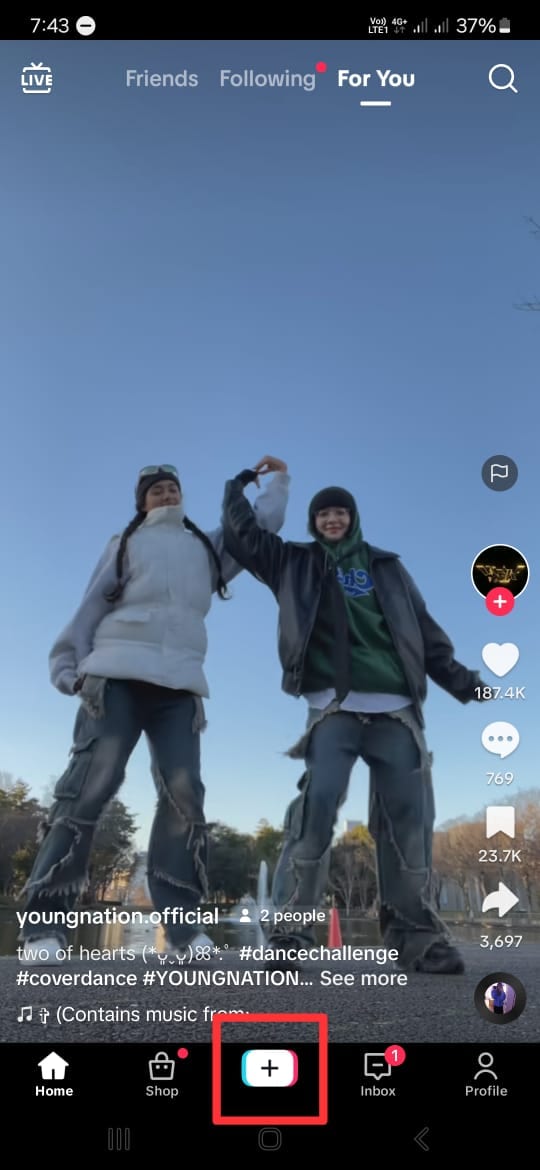
- Step 2. Add a song that you want to lip-sync to.
Next, click “Add Sound” with the musical note icon at the top of the screen. If you have a specific song in mind, you can find it by searching it on the search tab. Then, tap the song and click the check icon beside it.
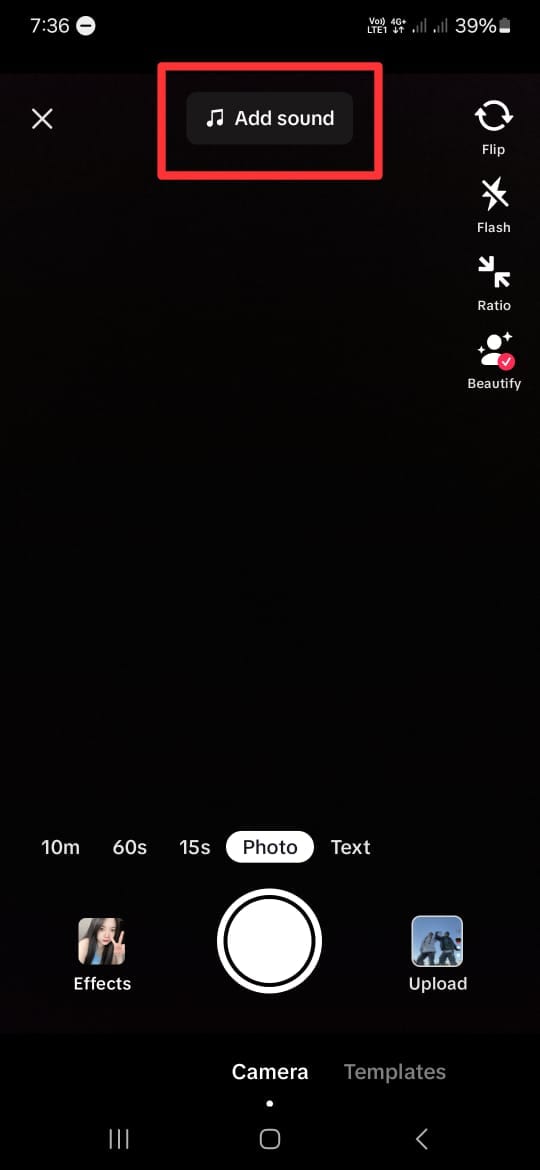
- Step 3. Choose the duration and the part of the song.
After choosing the song you want, you will return to the recording screen. Here, select your video duration at the bottom of the screen. You can choose between 10 minutes, 60 seconds, and 15 seconds. Remember that the duration of the songs on TikTok is usually only 30 to 60 seconds.
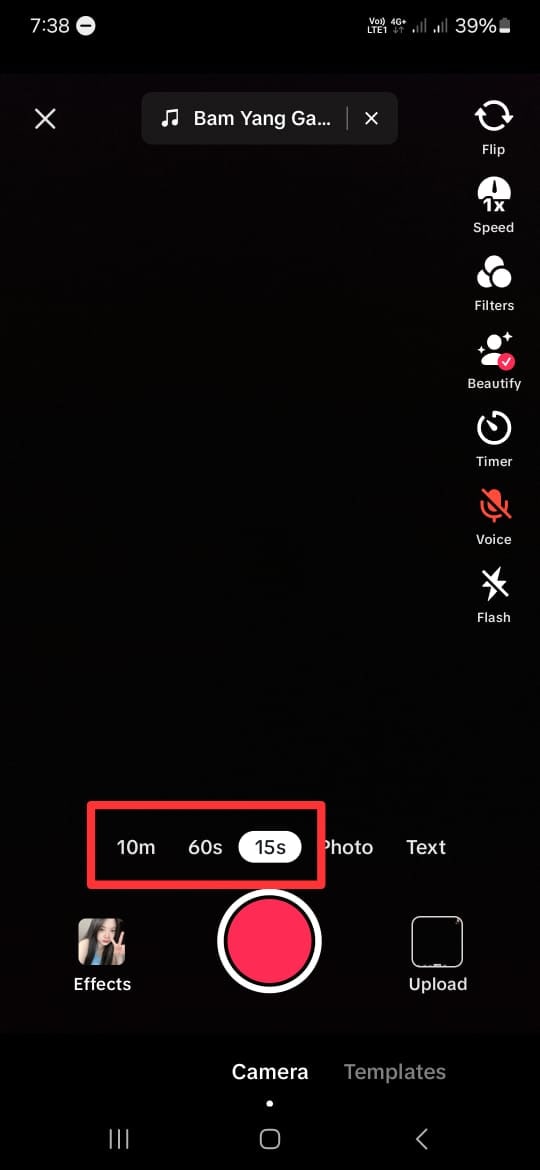
- Step 4. Choose the part of the song.
TikTok allows you to change the part of the song when lip-sync. However, the duration of the video should be less than the duration of the chosen song.
To do this, click on the song’s name at the top of your screen. Then, the bottom of your screen will display your chosen song. Tap the scissor icon and slide the playback to change the part of the song. Click “Done” once you have finished editing.

- Step 5. Tap on the red button.
If you are ready to record, tap the red button at the bottom of your screen. Then TikTok will play the chosen part of the song and record your lip-sync simultaneously. You can pause and continue the recording by clicking the same red button.
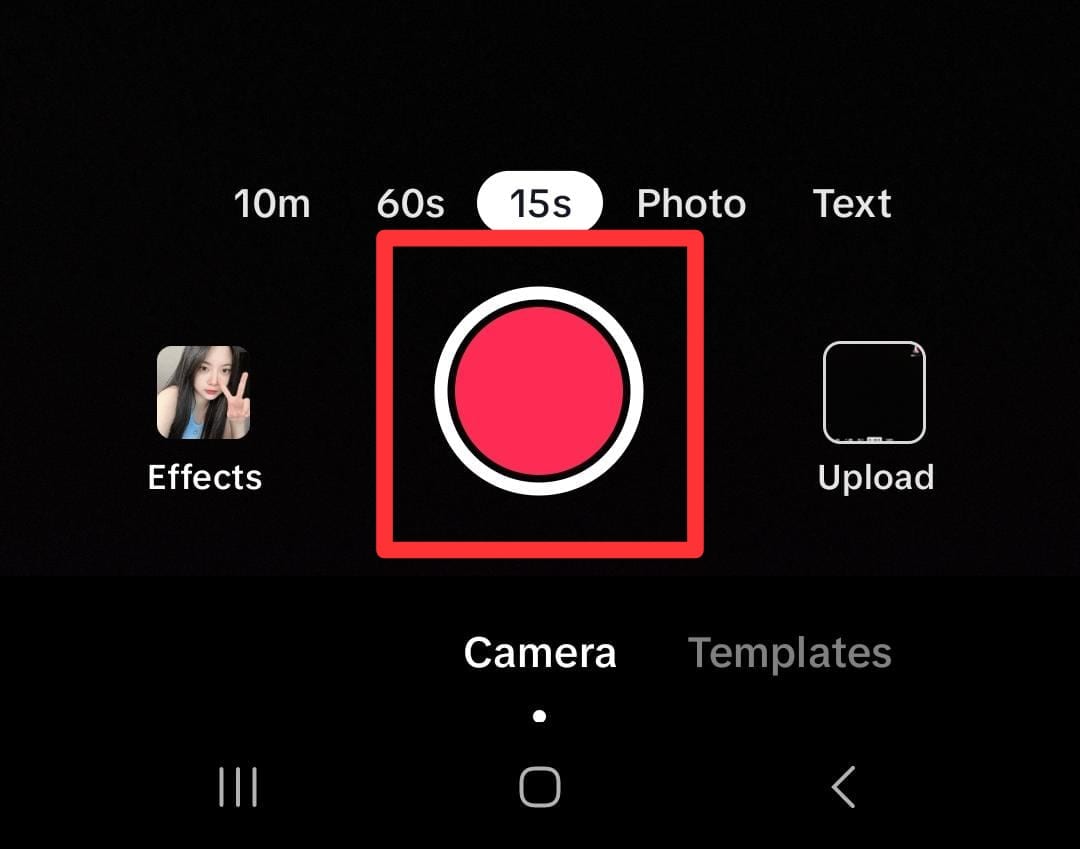
- Step 6. Post the video.
If you are satisfied with the results of your edits, click Next to proceed to the posting stage. Here, you can write a description and any other information you want. Click Post to share your lip-sync video to TikTok.

Creating a video on TikTok by lip-syncing is a fun and creative way to express yourself and connect with others. By following the steps above, you can create a lip-sync video on the TikTok app with ease. Keep in mind that by using these steps, you need to memorize the sentences and understand the beat of the chosen songs.
Part 3. How to Make Lip Sync Video Without Memorizing the Words
Making a **TikTok lip-sync video can be challenging because you must remember and match the words with the music. But there are three simple methods to make it easier.
Method 1: Record at slower speed
You can slow the speed down while recording instead of trying to keep up with the song. This technique lets you hear, understand, and follow the words more easily.
Here’s how to slow down the recording:
- Step 1. Follow steps 1 to 4 from the step-by-step guide in Part 2.
Start by following the first to fourth steps from the guide in Part 2 above.
- Step 2. Set the speed record slower.
On the recording screen, click on the Speed icon on the right side of the screen. To make it slower, choose 2x or 3x. This step will make your recording time 2 or 3 times longer than it should be.
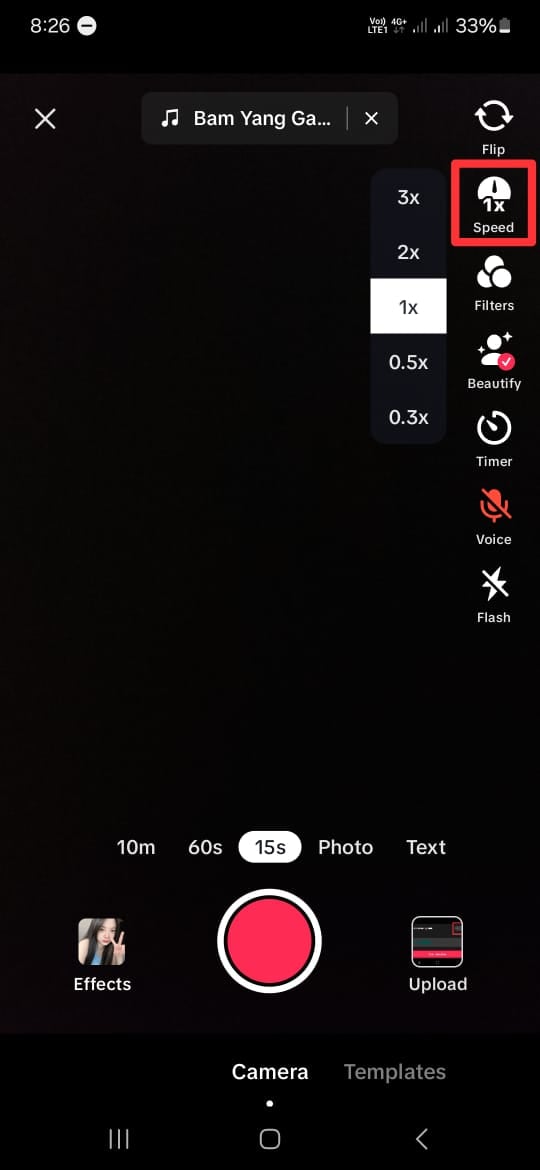
- Step 3. Tap on the red button.
Once you tap the red button, TikTok will play the song slower and record your lip-sync simultaneously. Repeat this step to help you memorize the lyrics and the beat of the songs.
Once you’re comfortable, switch back to normal speed for the final recording. This method will save time and improve accuracy.
Method 2: Purposely delay mouthing the words
While lip-syncing videos may vary in style and pacing, this technique can prove particularly useful for slower rhythms. Moreover, mastering the art of mouth sync on TikTok can elevate the overall production value of lip-syncing videos.
Using the timer feature will give you a slight lag between lip movements and audio playback. Then, it lets creators ensure more precise synchronization during editing. Here’s how to lip-sync on TikTok more easily:
- Step 1. Follow steps 1 to step 4 from the step-by-step guide in Part 2.
Like Method 1, you can start by following the first to fourth steps from the guide in Part 2 above.
- Step 2. Delay the recording
On the recording screen, click on the Timer icon on the right side of the screen. Here, you can set the timer to 3 to 10 seconds to delay the recording’s start. You can also drag and set the recording limit if you want.
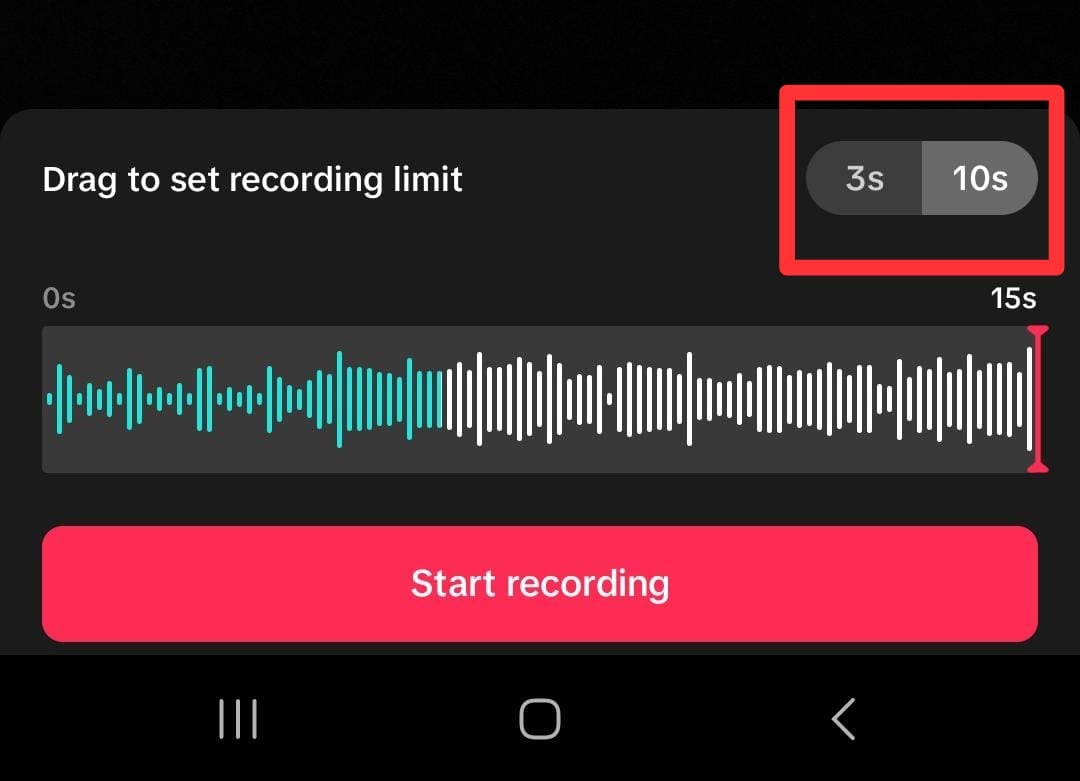
- Step 3. Start the recording
Then click “Start recording” to record the video with the timer on.
Method 3: Use a Photo Talking Tool
Next, consider using a Talking Photo feature by Wondershare Virbo. This method is for you who want to create engaging TikTok lip-sync videos without memorizing the words.
Virbo’s Talking Photo feature tool lets you upload a portrait of your photo and then make it appear as though it is speaking along with the audio. You do not have to install the app because you can use this feature online on their official website.
Here’s how to use Wondershare Virbo - Photo Talking feature to create a TikTok lip-sync video:
- Step 1. Start a new project.
Open the Wondershare Virbo website and tap the talking photo function to start a new project.
Get Started Online Free Download
- Step 2. Upload a portrait.
Tap “Upload Photo”, then upload a picture you want to use by following the instructions.
- Step 3. Edit and export.
Insert the text and adjust the voice settings. If you want to insert your own audio, you can use Wondershare Virbo for mobile or Desktop to upload or record your audio. Then, tap “Generate Video” to export.
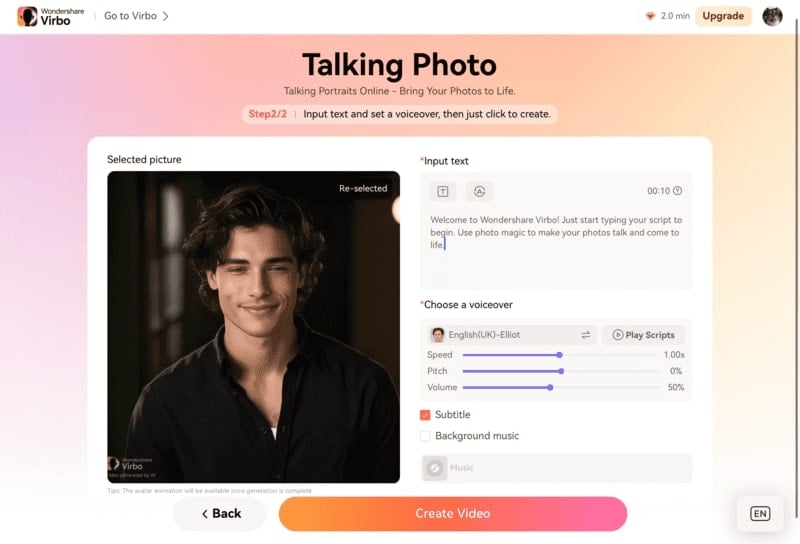
Now, you have successfully made your own TikTok lip-sync video. You can upload it to TikTok and share it with your followers. For more detailed instructions, you can see how to use Virbo’s Photo Talking tool .
Part 4: How To Lipsync Your Video to Any Language Using AI Video Translator
In today’s globalized world, reaching audiences in different languages is important for effective communication. Thanks to technological advancements, there is a tool that can help you translate video content.
Wondershare Virbo – Video Translator offers seamless solutions to translate video content into various languages with AI. Virbo ensures high-quality translations that maintain the integrity and impact of your original message.
How to lipsync TikTok videos to any language with Wondershare Virbo - Video Translator:
- Step 1. Go to Virbo’s official website , then click Generate AI Video Online.

Get Started Online Free Download
- Step 2. Log in or create an account.
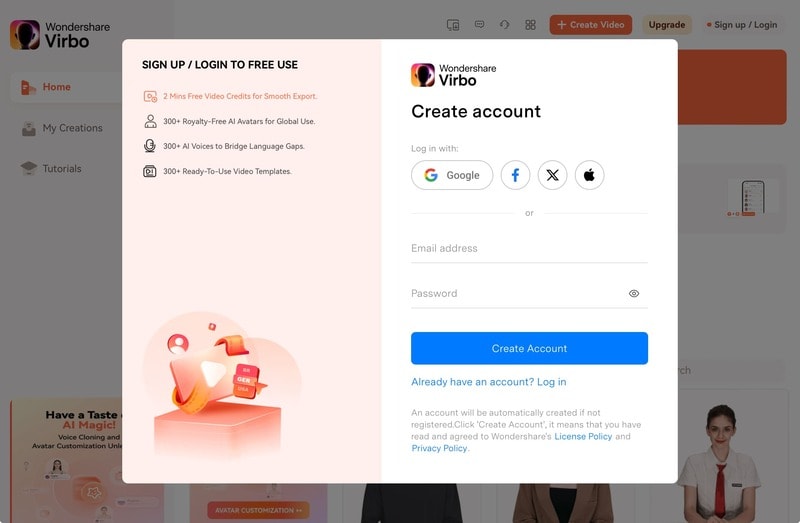
- Step 3. Then, navigate to the Video Translator tool on the Virbo’s homepage.
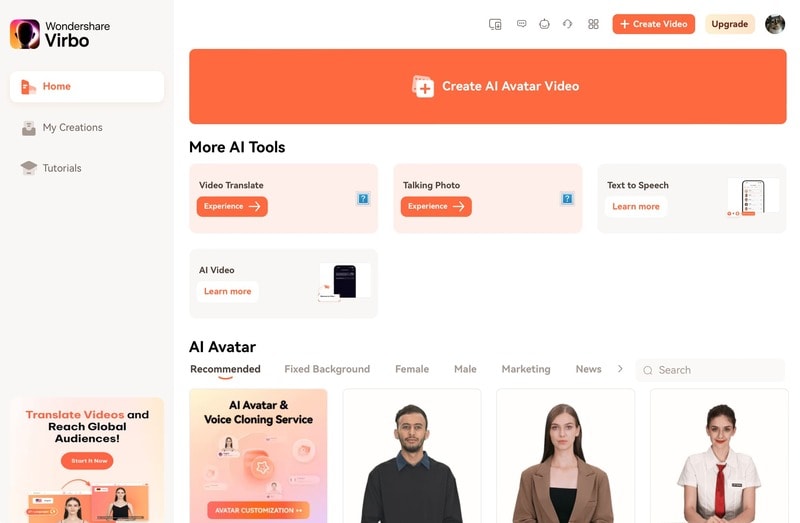
- Step 4. Upload the video.
Once inside the Video Translator interface, upload the video file you wish to translate. Select the original video language and the preferred target language from the available options. Additionally, enable the Lip Sync feature to ensure that the translated audio aligns perfectly with the lip movements in the video.
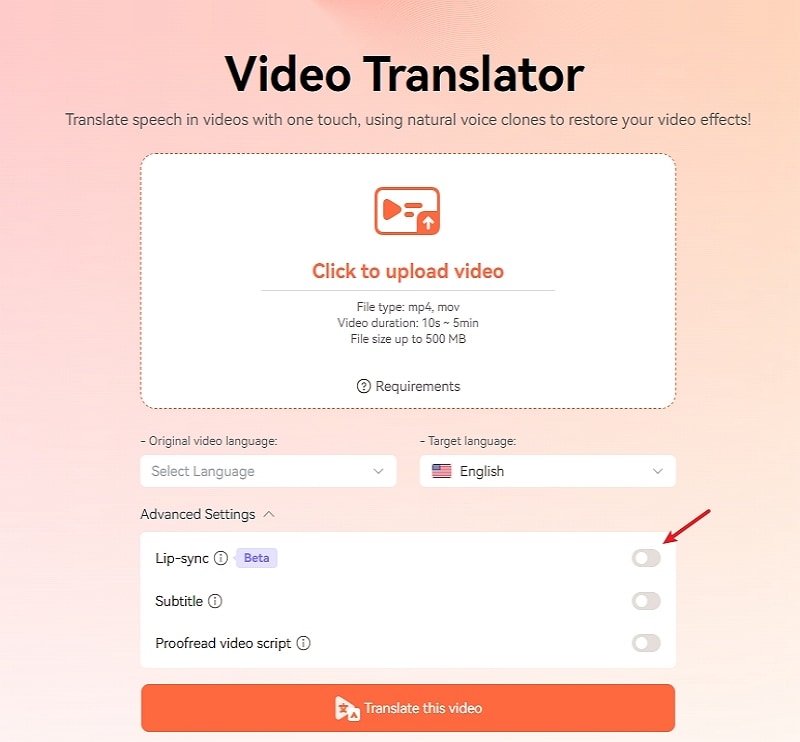
- Step 5. Click “Translate this video” to start translating the video.
Virbo’s Video Translator will use its advanced algorithms to translate the audio and synchronize it with the video seamlessly. Depending on the length and complexity of the video, the translation process may take some time.
Conclusion
Lip-syncing on TikTok has become a significant aspect of TikTok culture. It helps users show their creativity, entertain people, and maybe even become famous. Making **mouth sync TikTok videos usually means remembering lines and matching them to music, but there’s an easier way with Wondershare Virbo’s Talking Photo tool. This tool allows you to upload a portrait and sync it with audio without remembering the lines.
Also, Wondershare Virbo has a Video Translator tool that allows you to translate videos seamlessly into any language. This translator tool helps you communicate with people worldwide and maintain the original message.
TikTok has transformed the social media landscape through its short-form video content. They encourage users to make creative content using popular audio clips. Which enables them to entertain, gain recognition, and contribute to the platform.
Lip-syncing is a big part of what makes TikTok popular. Many users post lip-syncing videos that imitate voices from songs, movies, or trending audio clips. This art of lip-syncing has become an essential element of TikTok’s culture. Now, you might wonder **how to lip-sync on TikTok videos. This article will teach us how to make it effortlessly.
Part 1. Why Do People Lip Sync on TikTok?
Lip-syncing involves mimicking the words or vocals of an existing audio track. TikTok users take this concept to new heights by lip-syncing popular songs or clips. Lip-sync is appealing because it lets people get creative and reach a large audience.
Here are a few reasons why people engage in **lip sync TikTok:
- Self-expression: Lip-sync allows users to embody their favorite artists or characters by showcasing their personality and creativity.
- Entertainment: Many users lip-sync to entertain followers. They offer comedic performances, heartfelt renditions, or engaging storytelling.
- Virality: TikTok’s algorithm favors engaging content and well-executed lip-sync videos. They have the potential to go viral, rapidly gaining likes, shares, and followers.
Part 2. How to Make Lip Sync Video on TikTok
Here’s the step-by-step guide on how to lip sync on TikTok and captive your followers:
- Step 1. Open the TikTok app and tap the “+” button.
Start with opening the TikTok app on your phone. Then, tap the “+” button at the bottom of your screen to make a new video.

- Step 2. Add a song that you want to lip-sync to.
Next, click “Add Sound” with the musical note icon at the top of the screen. If you have a specific song in mind, you can find it by searching it on the search tab. Then, tap the song and click the check icon beside it.

- Step 3. Choose the duration and the part of the song.
After choosing the song you want, you will return to the recording screen. Here, select your video duration at the bottom of the screen. You can choose between 10 minutes, 60 seconds, and 15 seconds. Remember that the duration of the songs on TikTok is usually only 30 to 60 seconds.

- Step 4. Choose the part of the song.
TikTok allows you to change the part of the song when lip-sync. However, the duration of the video should be less than the duration of the chosen song.
To do this, click on the song’s name at the top of your screen. Then, the bottom of your screen will display your chosen song. Tap the scissor icon and slide the playback to change the part of the song. Click “Done” once you have finished editing.

- Step 5. Tap on the red button.
If you are ready to record, tap the red button at the bottom of your screen. Then TikTok will play the chosen part of the song and record your lip-sync simultaneously. You can pause and continue the recording by clicking the same red button.

- Step 6. Post the video.
If you are satisfied with the results of your edits, click Next to proceed to the posting stage. Here, you can write a description and any other information you want. Click Post to share your lip-sync video to TikTok.

Creating a video on TikTok by lip-syncing is a fun and creative way to express yourself and connect with others. By following the steps above, you can create a lip-sync video on the TikTok app with ease. Keep in mind that by using these steps, you need to memorize the sentences and understand the beat of the chosen songs.
Part 3. How to Make Lip Sync Video Without Memorizing the Words
Making a **TikTok lip-sync video can be challenging because you must remember and match the words with the music. But there are three simple methods to make it easier.
Method 1: Record at slower speed
You can slow the speed down while recording instead of trying to keep up with the song. This technique lets you hear, understand, and follow the words more easily.
Here’s how to slow down the recording:
- Step 1. Follow steps 1 to 4 from the step-by-step guide in Part 2.
Start by following the first to fourth steps from the guide in Part 2 above.
- Step 2. Set the speed record slower.
On the recording screen, click on the Speed icon on the right side of the screen. To make it slower, choose 2x or 3x. This step will make your recording time 2 or 3 times longer than it should be.

- Step 3. Tap on the red button.
Once you tap the red button, TikTok will play the song slower and record your lip-sync simultaneously. Repeat this step to help you memorize the lyrics and the beat of the songs.
Once you’re comfortable, switch back to normal speed for the final recording. This method will save time and improve accuracy.
Method 2: Purposely delay mouthing the words
While lip-syncing videos may vary in style and pacing, this technique can prove particularly useful for slower rhythms. Moreover, mastering the art of mouth sync on TikTok can elevate the overall production value of lip-syncing videos.
Using the timer feature will give you a slight lag between lip movements and audio playback. Then, it lets creators ensure more precise synchronization during editing. Here’s how to lip-sync on TikTok more easily:
- Step 1. Follow steps 1 to step 4 from the step-by-step guide in Part 2.
Like Method 1, you can start by following the first to fourth steps from the guide in Part 2 above.
- Step 2. Delay the recording
On the recording screen, click on the Timer icon on the right side of the screen. Here, you can set the timer to 3 to 10 seconds to delay the recording’s start. You can also drag and set the recording limit if you want.

- Step 3. Start the recording
Then click “Start recording” to record the video with the timer on.
Method 3: Use a Photo Talking Tool
Next, consider using a Talking Photo feature by Wondershare Virbo. This method is for you who want to create engaging TikTok lip-sync videos without memorizing the words.
Virbo’s Talking Photo feature tool lets you upload a portrait of your photo and then make it appear as though it is speaking along with the audio. You do not have to install the app because you can use this feature online on their official website.
Here’s how to use Wondershare Virbo - Photo Talking feature to create a TikTok lip-sync video:
- Step 1. Start a new project.
Open the Wondershare Virbo website and tap the talking photo function to start a new project.
Get Started Online Free Download
- Step 2. Upload a portrait.
Tap “Upload Photo”, then upload a picture you want to use by following the instructions.
- Step 3. Edit and export.
Insert the text and adjust the voice settings. If you want to insert your own audio, you can use Wondershare Virbo for mobile or Desktop to upload or record your audio. Then, tap “Generate Video” to export.

Now, you have successfully made your own TikTok lip-sync video. You can upload it to TikTok and share it with your followers. For more detailed instructions, you can see how to use Virbo’s Photo Talking tool .
Part 4: How To Lipsync Your Video to Any Language Using AI Video Translator
In today’s globalized world, reaching audiences in different languages is important for effective communication. Thanks to technological advancements, there is a tool that can help you translate video content.
Wondershare Virbo – Video Translator offers seamless solutions to translate video content into various languages with AI. Virbo ensures high-quality translations that maintain the integrity and impact of your original message.
How to lipsync TikTok videos to any language with Wondershare Virbo - Video Translator:
- Step 1. Go to Virbo’s official website , then click Generate AI Video Online.

Get Started Online Free Download
- Step 2. Log in or create an account.

- Step 3. Then, navigate to the Video Translator tool on the Virbo’s homepage.

- Step 4. Upload the video.
Once inside the Video Translator interface, upload the video file you wish to translate. Select the original video language and the preferred target language from the available options. Additionally, enable the Lip Sync feature to ensure that the translated audio aligns perfectly with the lip movements in the video.

- Step 5. Click “Translate this video” to start translating the video.
Virbo’s Video Translator will use its advanced algorithms to translate the audio and synchronize it with the video seamlessly. Depending on the length and complexity of the video, the translation process may take some time.
Conclusion
Lip-syncing on TikTok has become a significant aspect of TikTok culture. It helps users show their creativity, entertain people, and maybe even become famous. Making **mouth sync TikTok videos usually means remembering lines and matching them to music, but there’s an easier way with Wondershare Virbo’s Talking Photo tool. This tool allows you to upload a portrait and sync it with audio without remembering the lines.
Also, Wondershare Virbo has a Video Translator tool that allows you to translate videos seamlessly into any language. This translator tool helps you communicate with people worldwide and maintain the original message.
Also read:
- [Updated] 2024 Approved Storytelling Mastery Scriptwriting Secrets Revealed
- [Updated] Effective YouTube Card Usage Guide for 2024
- [Updated] In 2024, Discovering the Perfect Shape Tailoring Aspect Ratios in Videos
- [Updated] QuickGuide OptimizingYouCamRecord
- 6 Ways To Transfer Contacts From Motorola Edge 40 Neo to iPhone | Dr.fone
- Best 10 Chinese Video to English Translator
- Can Life360 Track You When Your Asus ROG Phone 7 is off? | Dr.fone
- In 2024, Easily Unlock Your Meizu 21 Pro Device SIM
- Mastering Emotional Intelligence Through Conversations with ChatGPT
- New 2024 Approved Best Tool to Translate YouTube Video to Arabic
- New 2024 Approved Top 7 Online Auto Subtitle Translators for Content Creators
- New Auto Translate YouTube Videos Into Different Languages
- New How to Translate Audio/Video Content From Spanish to English and Vice Versa, In 2024
- New In 2024, Auto Translate YouTube Videos Into Different Languages
- Proven Ways in How To Hide Location on Life360 For Vivo V30 Pro | Dr.fone
- Translate Videos with Subtitle Cat Your Essential Guide for 2024
- Updated Chrome Video Translators Top 5 Video Translation Chrome Extensions for 2024
- Title: Translate Video From Japanese to English Online for Free for 2024
- Author: Susan
- Created at : 2024-09-24 16:58:54
- Updated at : 2024-09-30 21:31:47
- Link: https://ai-video-translation.techidaily.com/translate-video-from-japanese-to-english-online-for-free-for-2024/
- License: This work is licensed under CC BY-NC-SA 4.0.

